Boots: 2024-2025 Lange Shadow 130 LV & Shadow 130 MV
Days Skied (combined): ~130
Test Locations: Crested Butte Mountain Resort, CO; Alyeska & Chugach Powder Guides, AK
Stated Flex: 130
Available Sizes: 24–31.5
Stated Last (size 26.5):
- Shadow LV: 97 mm
- Shadow MV: 100 mm
Blister’s Measured Weight (size 26.5 Shadow LV 130):
- Shells, no Liners: L: 1560 & R: 1560 g
- Liners, no Footbeds: L: 415 g & R: 419 g
- Shells + Liners = 1975 & 1979 g
- Stock Insoles: 23 & 23 g
[Note: Our review was conducted on the 23/24 Shadow 130 LV & Shadow 130 MV, which return unchanged for 24/25.]
Stated Forward Lean: 12° (16° w/ spoiler)
Stated Ramp Angle: 4°
Sizes Tested: 26.5 & 27.5
Stated Boot Sole Length (26.5): 303 mm
Buckles: 2 upper cuff, 2 lower shell
Power Strap: 45 mm velcro
Shell Material:
- Cuff: Dual-Core Polyurethane
- Lower Shell / Shoe: Dual-Core Polyurethane
Soles: GripWalk (Alpine available aftermarket from Lange)
Binding Compatibility: GripWalk & MN bindings
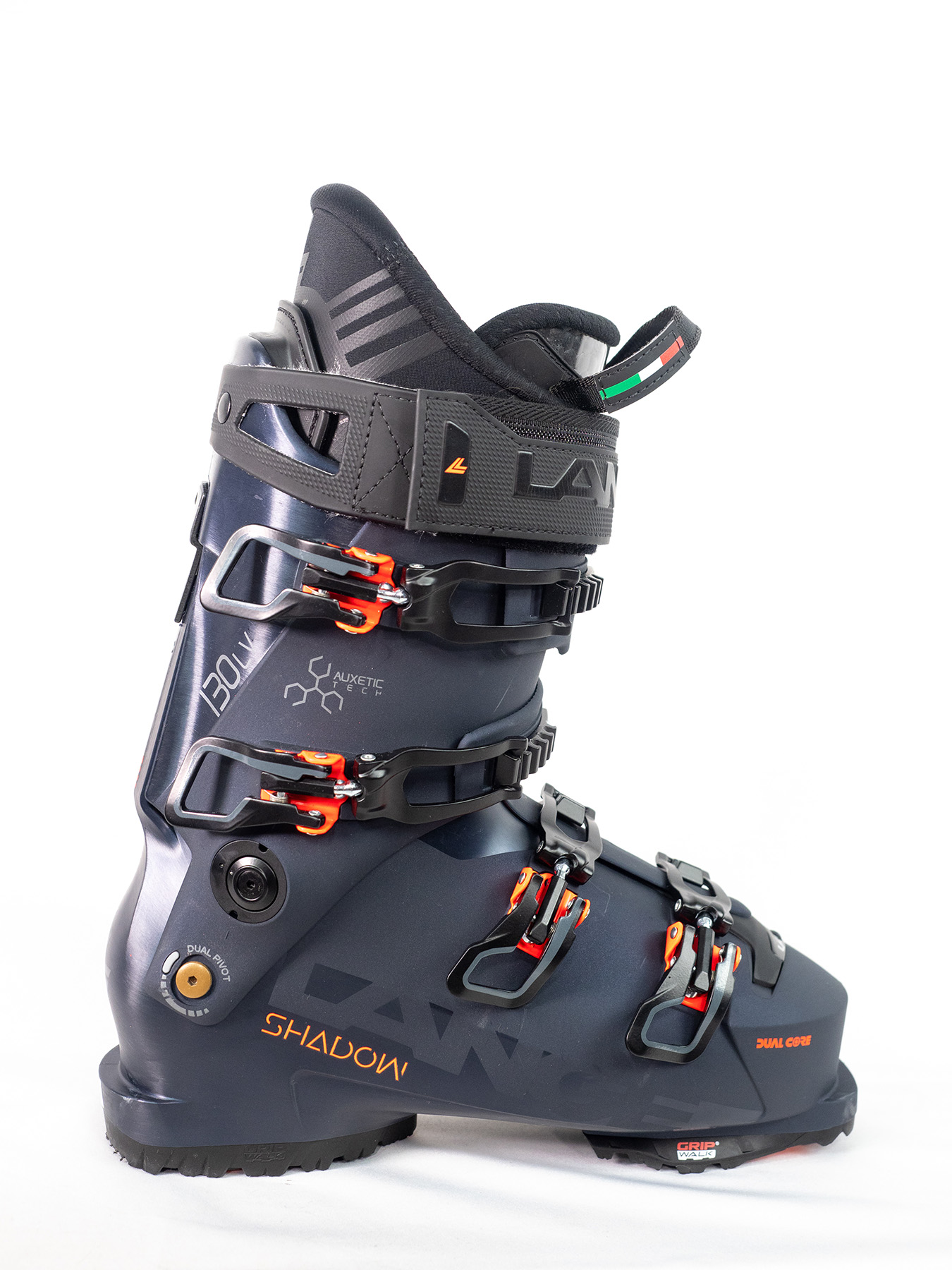
Intro
Lange launched a whole new series of ski boots for the 2023-2024 season, and there is a lot going on with the Shadow series.
We see new boots released every year, but rarely do we see boots that stray very far from established designs and silhouettes — especially in the fixed-cuff alpine category.
But the Shadow series forgoes convention in a few key areas, and Lange is talking a very big game about these new alpine boots.
The Shadow series returns for the 2024-2025 season, and two of our reviewers have been logging a LOT of time in the Shadow 130 LV and Shadow 130 MV since they were announced, so now it’s time to weigh in. First, let’s get into the details of the boots and their design:
The Lange Shadow lineup of boots
Similar to Lange’s other boot collections, nearly all of the Shadow boot models are available in two lasts, a 97 mm “LV” and a 100 mm “MV.”
Here’s a quick rundown on the Shadow lineup:
Shadow Men (size 24–31.5)
Shadow 130 LV & Shadow 130 MV
Shadow 120 LV & Shadow 120 MV
Shadow 110 LV & Shadow 110 MV
Shadow 100 MV
Shadow Women (size 22–27.5)
Shadow 115 W LV & Shadow 115 W MV
Shadow 95 W LV & Shadow 95 W MV
Shadow 85 W LV & Shadow 85 W MV
What Lange says about the Shadow Boots:
“’Give me a long enough lever… and I shall move the world.’ At Lange, innovation is in our DNA, and we’ve never stopped trying to move the world of skiing. We did it in 1962 when we introduced the first ever plastic ski boot, and we’re doing it again now, with a boot born from the darkest corners of our deepest workshops. Years in the making, the Shadow uses breakthrough dual-pivot technology for greater leverage, creating a chassis that requires half the energy to drive. Power when you want it, stability when you need it, finesse at its finest. Ski better—the Shadow shines a light.
Powerful, responsive, and easy. No boot has ever offered the confidence and stability of the Shadow, and we don’t say that kind of thing lightly at Lange. It’s all about leverage. The Shadow’s breakthrough dual-pivot technology harnesses extended leverage for unparalleled liveliness and drive. Pair that with a bold, new liner that uses space-aged Auxetic foam for a flawless connection, and performance has never felt so comfortable. Join the revolution—come out of the shadows.”
If you’re more of a visual person, here’s a video by Lange that quickly covers the highlights of the Shadow series:
There’s a lot going on here, so let’s start with arguably the most radical aspect of the Shadow boots:
Dual Pivot & Suspension Blade
For pretty much all the 2-piece / overlap boots out there, the upper cuff attaches to the lower shell via a single pivot point, and then in the case of most fixed-cuff alpine boots, the upper cuff is riveted to the lower shell on the back / spine of the boot. Despite all the new products every year, that simple layout has been one of the few (relative) constants in the ski boot world. Lange opted to change that with the Shadow boots.
When I first saw the Shadow boots, I immediately thought of mountain bike suspension designs, which often feature lots of different pivots to optimize various characteristics, one of the most notable being leverage / leverage ratios. Lange makes a similar comparison with their Dual Pivot layout, claiming the following benefits:
- Enhanced leverage = more power with less effort
- Suspension absorption and vibration damping
- Increased rebound
- Consistent flex
More concisely, they sum up the system as follows: “LESS FORWARD MOVEMENT WITH AMPLIFIED ENERGY & POWER TRANSMISSION”
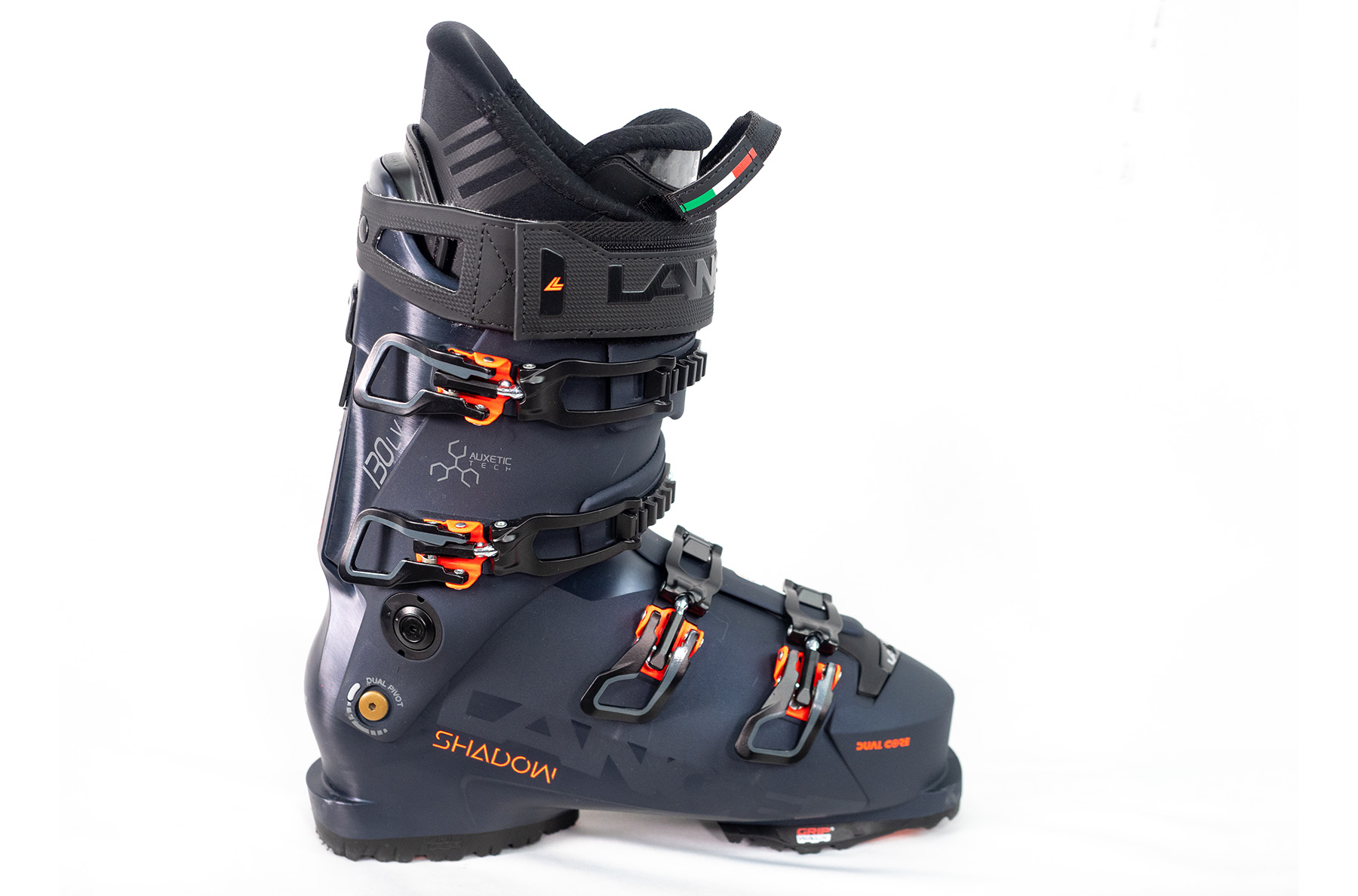
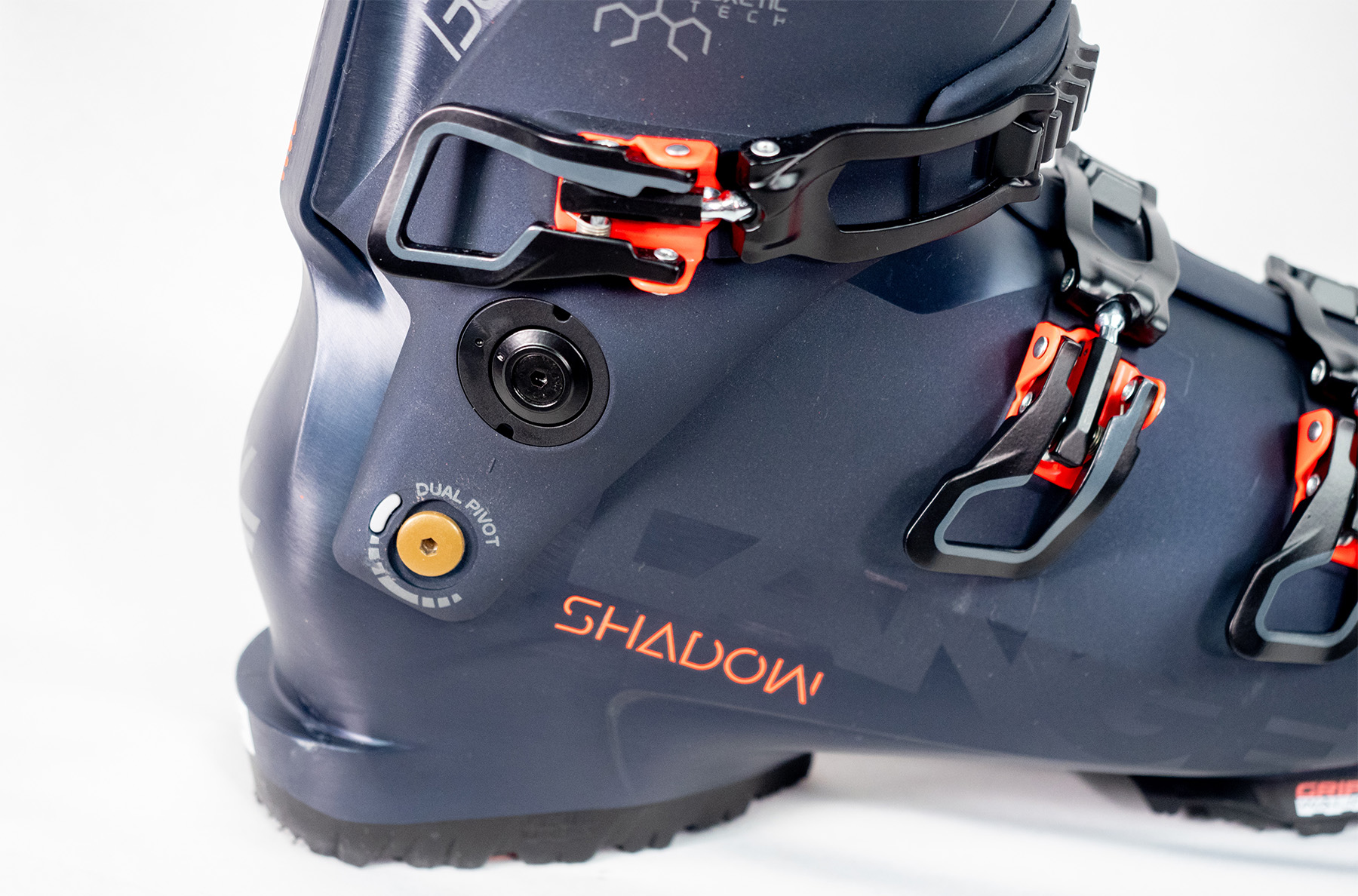
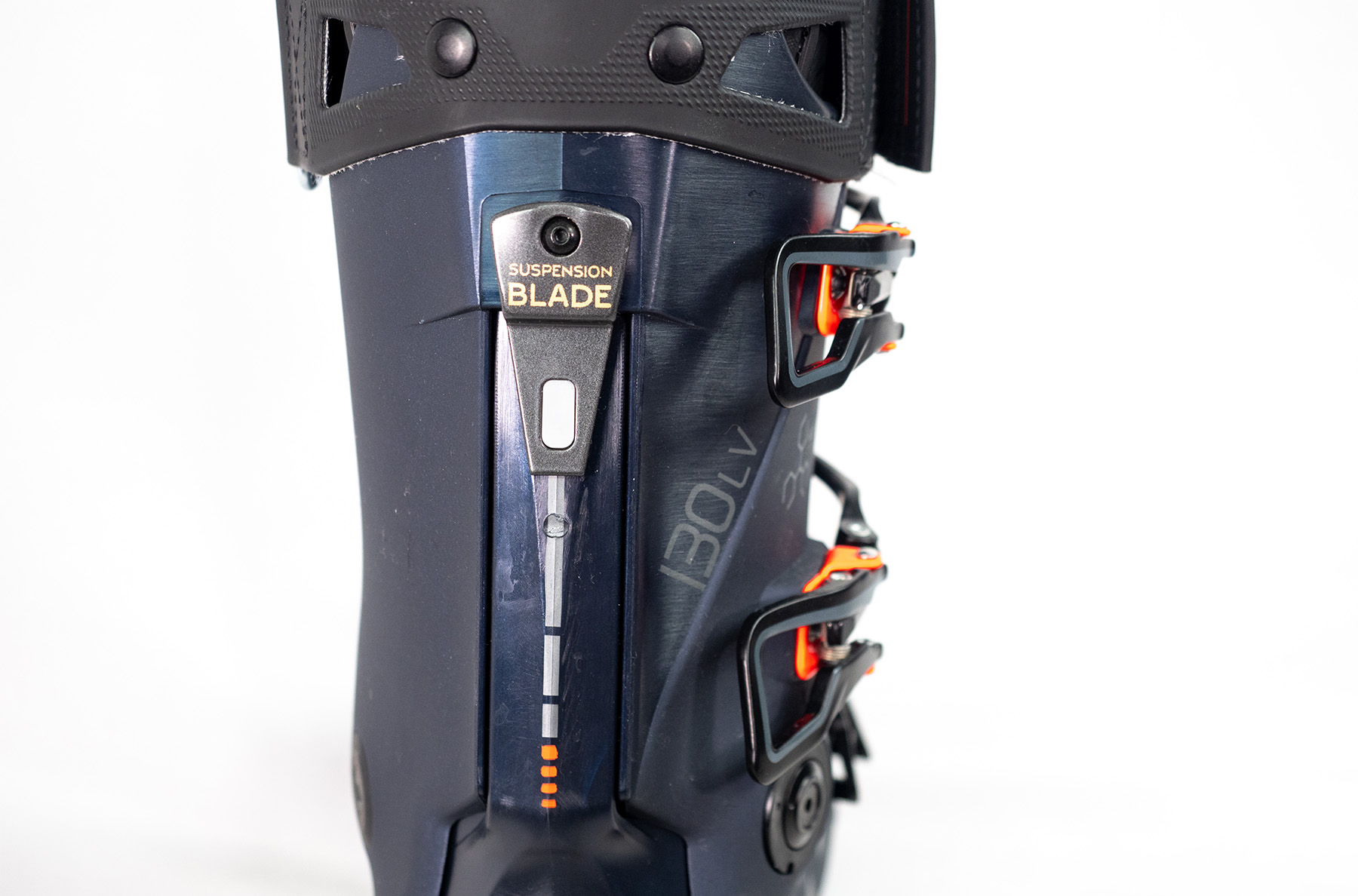
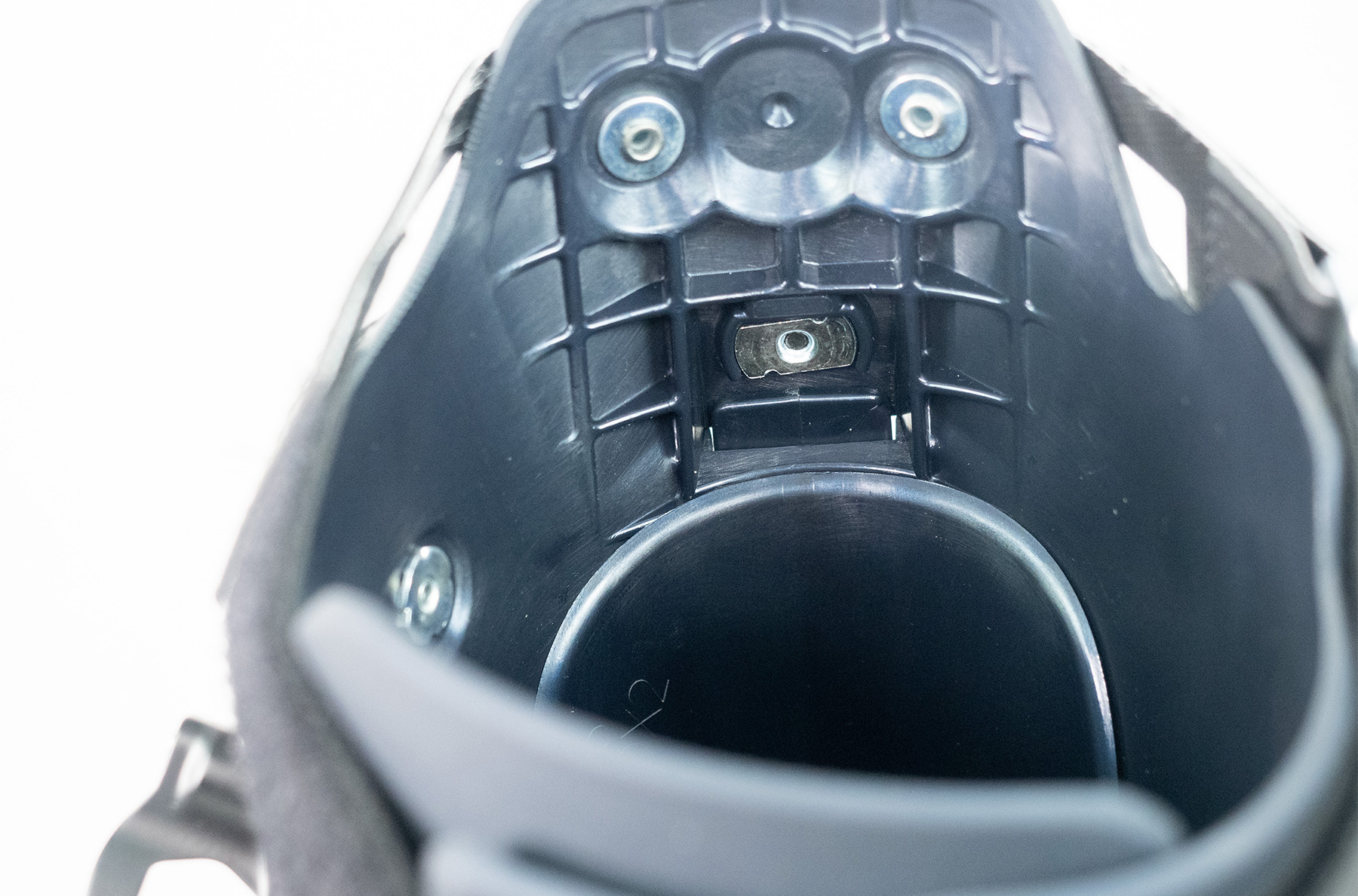
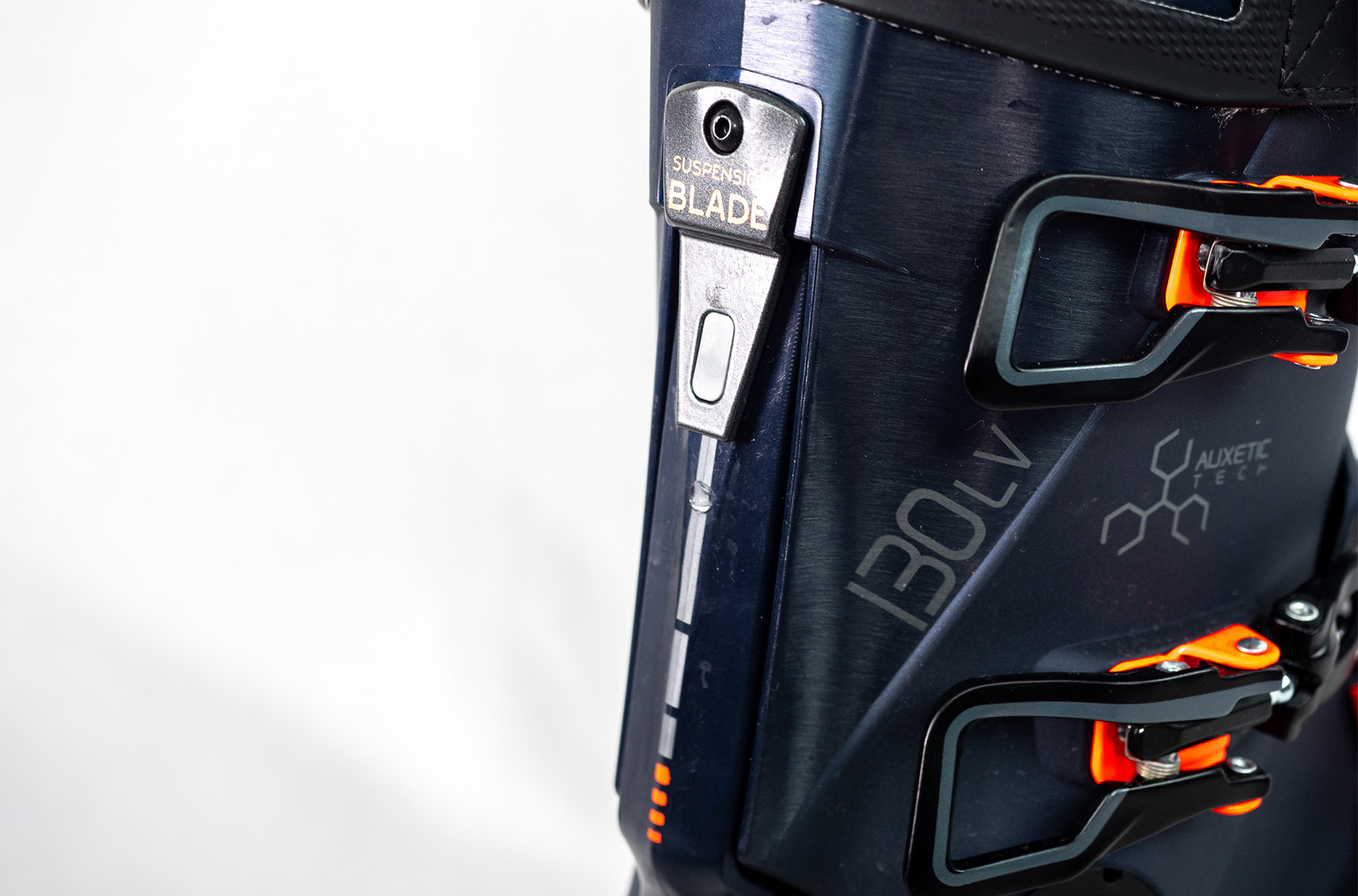
In short, the Shadow boots feature a main pivot point that looks similar to many 2-piece alpine boots, but then add another pivot below and behind the main one, and pair that with what they call a “Suspension Blade” — a flat piece that connects the upper cuff to the lower shell, pretty far up the spine of the boot (notably higher than where most fixed-cuff boots have their cuff / shell rivets).
Update 1.26.23: After discussing more with the folks at Lange, we can provide a bit more info on this system.
First off, one key element of the Dual Pivot + Suspension Blade design is the use of elastomers at both the lower pivot point and where the suspension blade attaches to the upper cuff. These elastomers are designed to help add some damping and rebound to the boot, and are also the way in which you can adjust the flex pattern of the Shadow boots. Different durometer elastomers will be available, which can reportedly soften the flex pattern of a given boot by approximately 10%.
In addition to being part of the “lever” formed in concert with the main and lower pivots, the Suspension Blade is also designed to add damping and rearward support, relative to a more traditional 2-piece shell design.
And to further distill the end result of this system: the Shadow boot design is meant to allow the skier to transfer more power into the ski with less effort. I.e., it doesn’t necessarily make the boot easier to flex, but instead makes it easier for the skier to put more power into the ski, bend the ski more easily, etc. It reportedly does this by offering a more linear power delivery, as opposed to traditional 2-piece boots, which have a more progressive / elliptical power delivery, wherein they don’t transfer all that much power at first (and are easier to bend at first), but then ramp up significantly the deeper / harder you flex them. Lange also claims that the Shadow design delivers its power to a broader area of the ski.
Shell
In terms of materials, the Shadow 130, Shadow 120, Shadow 115 W, and Shadow 95 W all feature Lange’s Dual Core polyurethane for both the upper cuff and lower shell. The Shadow 110, Shadow 100, and Shadow 85 W feature a Lyfran cuff. Lange has now been using their Dual Core construction for several years, but in short, it’s a co-injection process that allows them to implement plastics of different hardness where needed to optimize power transmission, rebound, flex pattern, ease of getting in / out, etc.
Liner
The Shadow’s unique exterior silhouette is very eye catching, but there’s also a lot going on with the Shadow’s liner. For one, it features a very substantial tongue that’s made with a PU foam that’s similar to Adidas’ “Boost” foam, with the goal of increasing energy absorption and rebound.
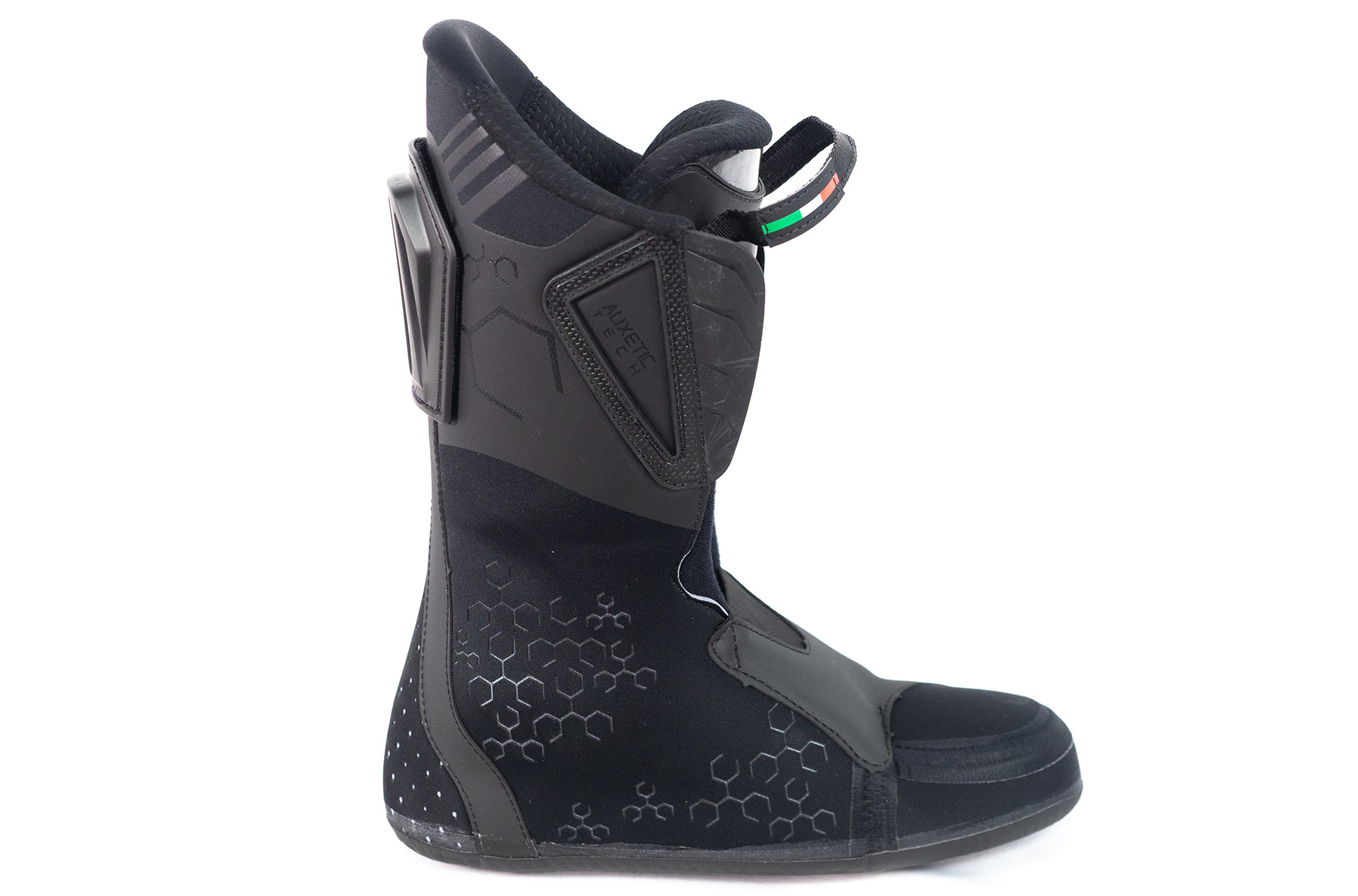
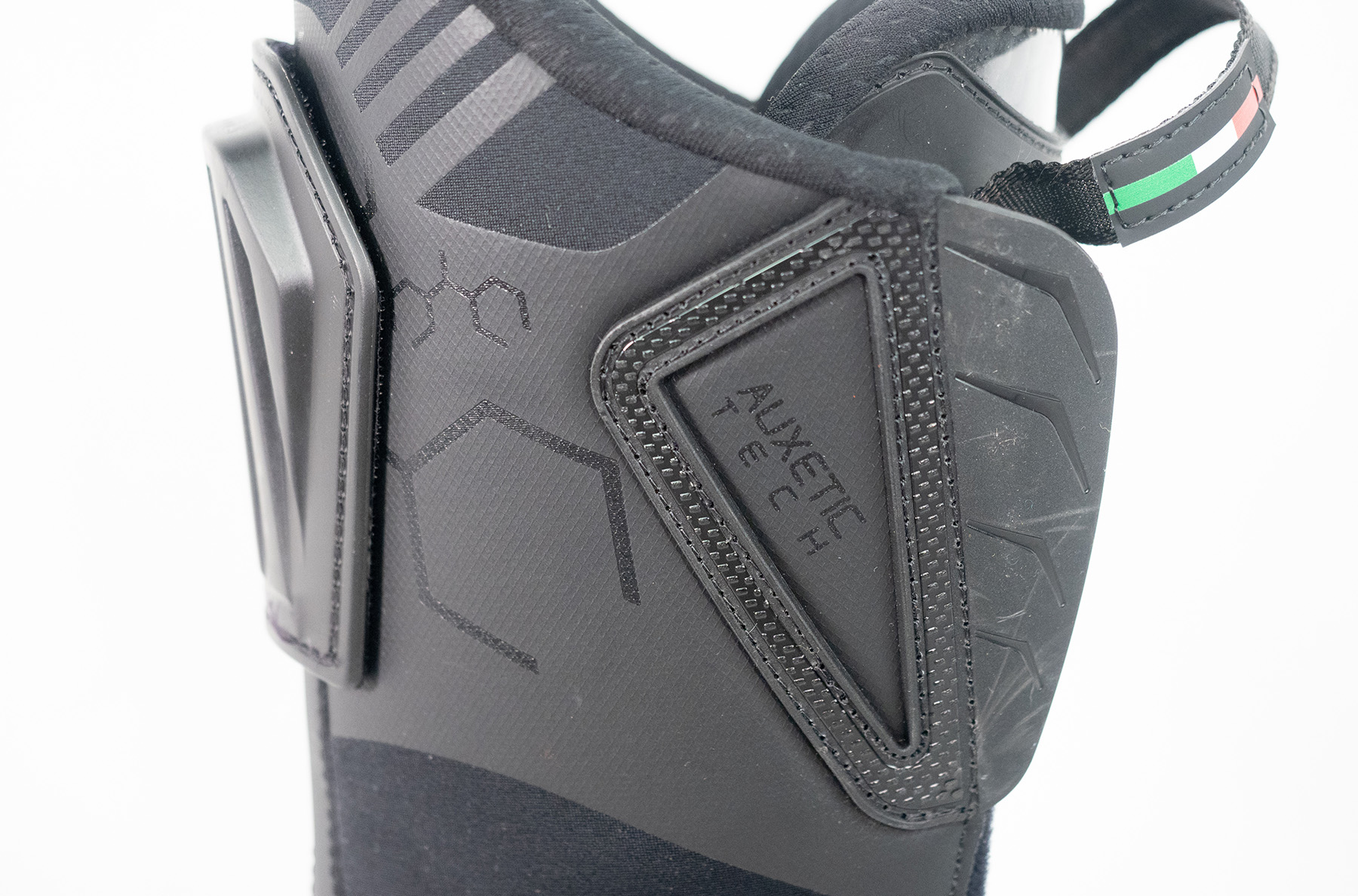
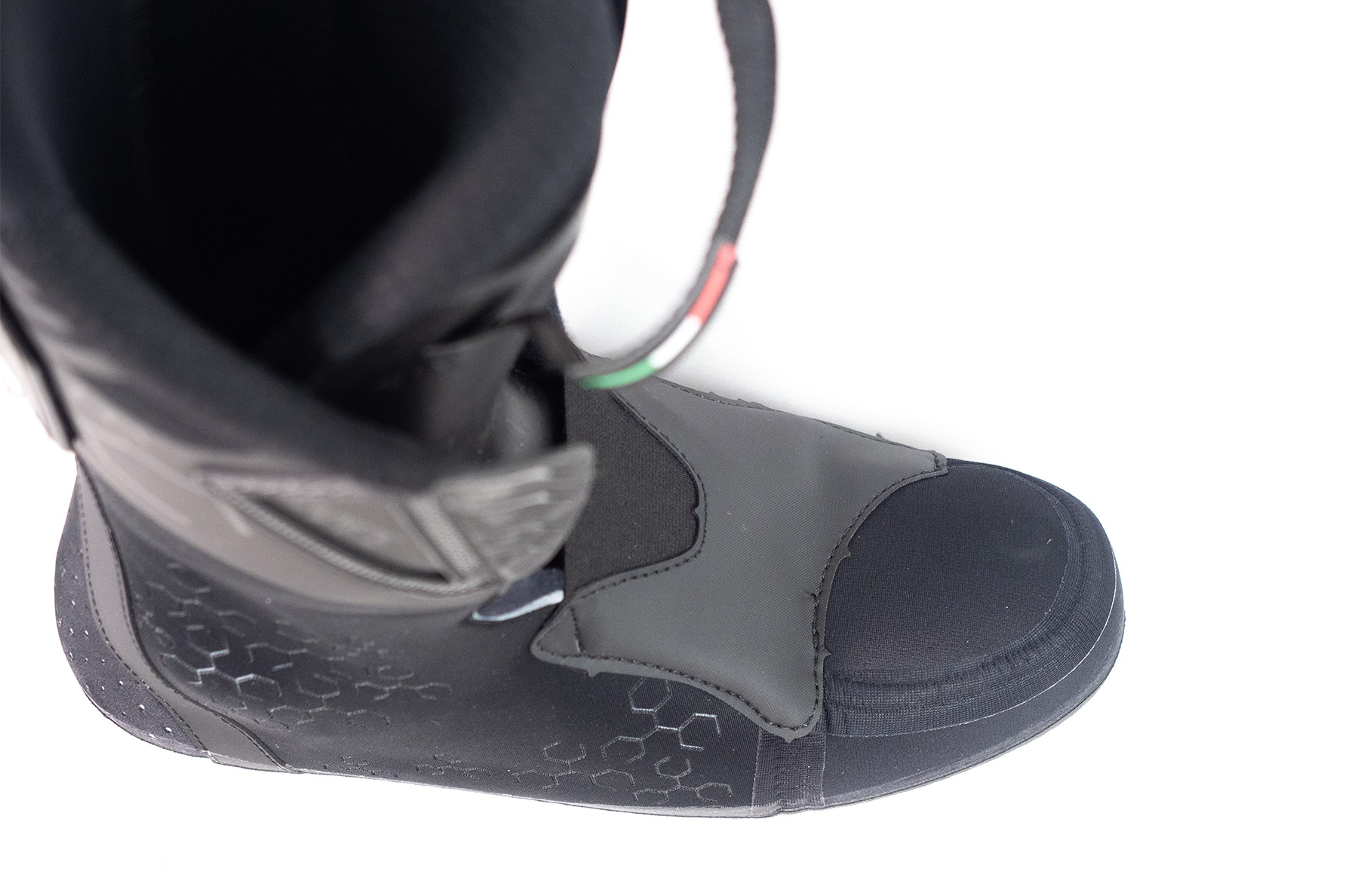
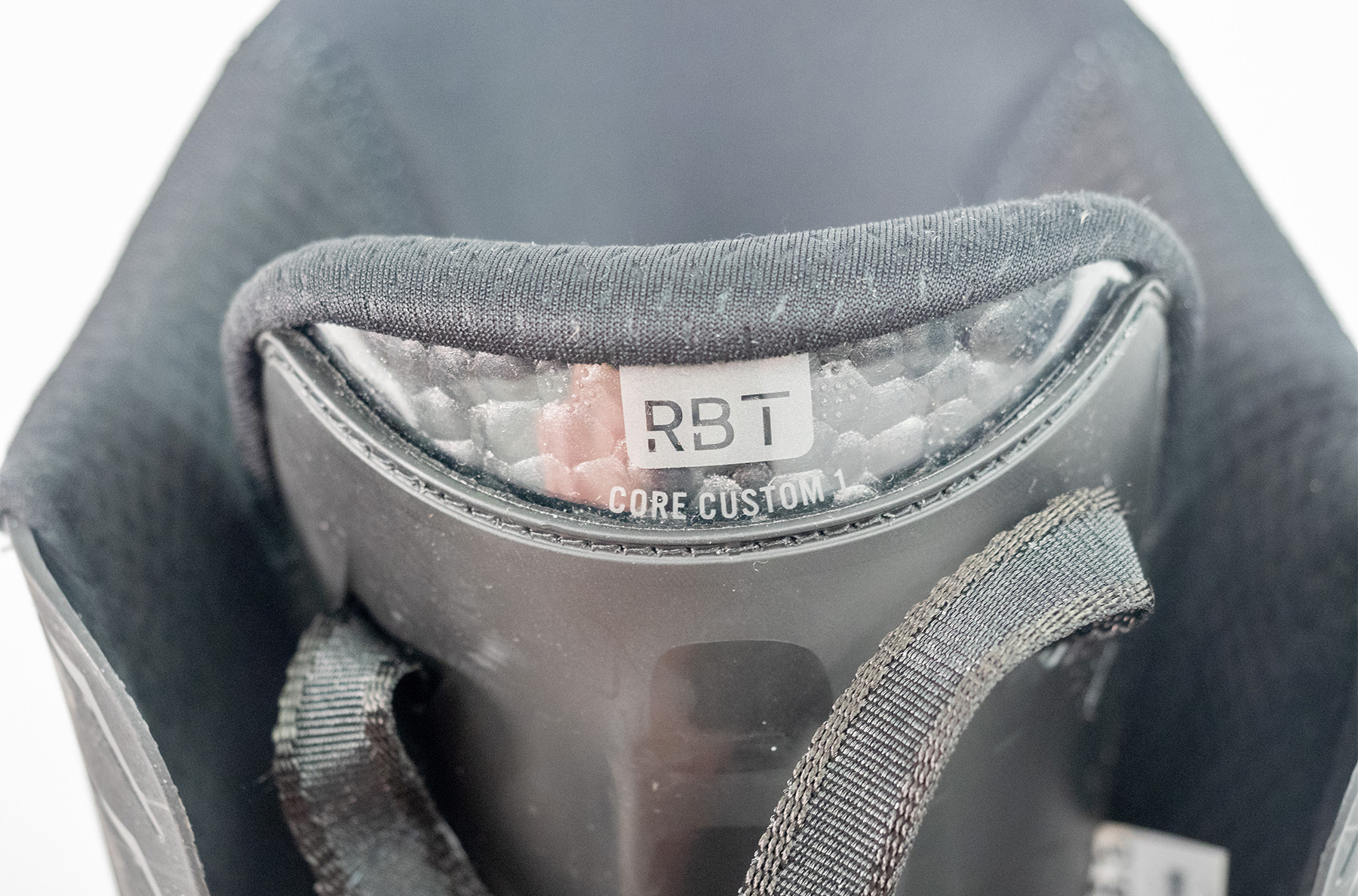
The Shadow liner is also very minimal when it comes to seams; Lange aimed to reduce as many potential pressure points as possible, including the integration of the upper cuff reinforcement into the liner itself, rather than being sewn on the outside like many other liners. They also claim that the liner’s “Auxetic Technology” allows the material to expand and contract more easily to follow and conform to natural foot shapes.
Buckles
The Shadow boots are pretty standard in this regard: they stick to pretty traditional, micro-adjustable buckles, with two on the upper cuff and two on the lower shell.
Power Strap
Nothing out of the ordinary here: the Shadow 130 gets a pretty big, 45 mm velcro-closure power strap.
Soles
All the Shadow boots come with GripWalk soles, but you’ll be able to order Alpine soles from a Lange dealer.
Cuff Adjustment
The Shadow boots feature cuff alignment tuning via the main pivot point.
Weight & Comparisons
The Shadow 130 is a bit lighter than some of Lange’s other fixed-cuff resort boots, such as the RX 130 and RS 130, though it’s not super light. I.e., it slots between some of the lightweight alpine boots (e.g., Atomic Hawx Ultra, K2 Recon) and more traditional, heavier models like Lange’s RX series and Head’s Formula series.
Below is a number of our measured weights of other boots with walk mechanisms. We list the weights of each shell + the weights of each liner, then the total weights of the shells + liners. You can click on the link for each boot to see which model year(s) the weights apply to.
K2 Recon Pro (26.5): 1334 & 1328 + 426 & 434 = 1760 & 1762 g
Atomic Hawx Ultra 130 S GW (26.5): 1375 & 1376 + 410 & 413 = 1785 & 1789 g
Salomon S/Pro Alpha 130 (26.5): 1408 & 1417 + 399 & 400 = 1807 & 1817 g
Nordica Promachine 130 (26.5): 1428 & 1428 + 444 & 445 = 1872 & 1873 g
Tecnica Mach1 LV 130 TD (26.5): 1518 & 1518 + 447 & 450 = 1965 & 1968 g
Lange Shadow 130 LV (26.5): 1560 & 1560 + 415 & 419 = 1975 & 1979 g
Rossignol Hi-Speed Elite 130 Carbon LV (26.5): 1610 & 1607 + 442 & 446 = 2052 & 2053 g
Head Formula RS 130 (26.5): 1587 & 1588 + 466 & 466 = 2052 & 2053 g
Lange RX 130 LV (26.5): 1676 & 1678 + 430 & 430 = 2106 & 2108
Lange RS 130 LV (26.5): 1634 & 1634 + 490 & 481 = 2123 & 2115 g
Atomic Redster CS 130 (26.5): 1773 & 1778 + 434 & 434 = 2208 & 2212 g
Head Raptor WCR 140S (26.5): 1849 & 1852 + 507 & 511 = 2356 & 2363 g
Head Raptor 140 RS (26.5): 1892 & 1899 + 547 & 548 = 2439 & 2447 g
Fit — Lange Shadow 130 LV
As always, our “Fit” sections will never replace the usefulness of the advice of an experienced bootfitter, nor are they designed to do so. The fit of any boot should be the deciding factor and everyone’s feet are different, so we highly, highly recommend visiting a bootfitter before settling on a boot. Want to find a reputable bootfitter? Check out our Blister Recommended Shops. With that said, here are some thoughts from Luke Koppa and Paul Forward on how the Shadow 130 LV and Shadow 130 MV fit their feet
Luke Koppa: For reference, I have a fairly wide midfoot (a little over 100 mm when unsupported), fairly low instep, low-volume ankle, and skinny calves. The Tecnica Mach1 MV is the boot with which I’ve gotten the best out-of-the-box fit.
Lange told us that the fit of the Shadow is quite similar overall to the 23/24 Lange RX / RS mold, but the Shadow reportedly has a slightly lower-volume heel pocket (reportedly similar to the original RX / RS), and the Shadow features 1 mm more room around the navicular area. The internal length is the same as the RS & RX, but the Shadow’s external Boot Sole Length (BSL) is about 3 mm shorter, which is part of why it comes in lighter than the RS / RX shells.
A few things stood out with the Shadow 130 LV’s fit; these impressions are all based on skiing in the boot with no modifications, apart from swapping the stock footbeds for my custom insoles. First, its instep feels pretty high / roomy; as someone with a fairly low instep, I definitely have too much room there, but as has been the case with some other Lange boots (the RX / RS and XT3 series, in particular), folks with high insteps should take note.
The fit through the midfoot was surprisingly comfortable; I often experience pain there, even with “Medium Volume” boots, but had no such issues in the Shadow 130 LV. The fit through the ankle and heel felt nicely snug, which helped counteract the extra space I have above my instep. At the cuff, I was able to get it very snug, but not without experiencing some pressure points on the lateral side of my leg between my ankle and calf. That’s something I’ve experienced in other boots and was eventually solved by swapping the stock liners for my ZipFit Gara HV liners.
On that note, while the Shadow LV’s stock liner left me with a pretty comfortable fit, it lacked the precision I’ve now come to prefer (specifically over the instep), having run ZipFit Gara HV liners in my Tecnica Mach1 MV boots last season. So, I swapped those ZipFits into the Shadow 130 LV and, after doing a brief heat-mold and skiing them for a few days, I was pretty happy.
However, I still had a bit more room above my instep than I’d like, and I would get midfoot pain on some days. So I worked with my bootfitter, Hunter Dagnon, at Mt. Crested Butte to (1) add another tube of ZipFit cork to each liner’s tongue and (2) add more posting support to my custom insoles to better support my arch and reduce how much my foot splayed out when weighted. After doing so, I’ve been very happy with the Shadow 130 LV + ZipFit Gara HV combo — my heel and ankle are nicely locked in, my instep is comfy but doesn’t have much space above it, my toes have plenty of room, and I rarely experience pain around my midfoot. After skiing that setup for a few weeks, I’m now thinking I could probably get away with adding another half-tube of ZipFit cork to each boot’s tongue, but I’m holding off on that for now.
Whether with the stock liner or my ZipFits, I prefer the Shadow with its (pretty thick) cuff spoiler added between the liner and shell cuff. Without the spoiler, my leg felt a bit more upright than I prefer.
Paul Forward: I’ve spent most of the past decade skiing in various versions of the Lange RX 130 LV and my general impression is that, if the RX LV works for you, the Shadow LV will as well. I’ve noticed some slight differences in the ankle pocket, specifically that the lower aspects of the ankle are a little tighter on my feet in the RX, but the difference is subtle. Both boots provided very good heel hold for me, and when I did swap over my ZipFit Garas from the RX 130, I was able to immediately start skiing in them without any liner work.
Lengthwise, the Shadow LV also feels the same as the RX series, and have found that, like the RX, the Shadows are a little longer than the Head Raptor 140 RS and a little shorter than the Fischer RC4 Pro MV. In a lot of LV boots, I experience pressure over the 5th metatarsal and “6th toe” area and have that area punched / stretched accordingly, but I did not find the need for that in the Shadow (or RX LV).
Fit — Lange Shadow 130 MV
Paul: I was excited to get the Shadow 130 MV to use for my job guiding heli-skiing because, for that application, I prioritize comfort and warmth over absolute maximum performance and precision. Still, I need a good fit and flex for driving big skis at high speeds while wearing a heavy guide pack.
The Shadow MV has a little more room over the instep than the LV, but I still found myself needing to use a ZipFit (with all the cork squished out of the instep area) to be able to use the Shadow MV for long days of guiding. There is also noticeably more room vertically in the toebox of the MV, which is what I was really hoping for in a guide boot.
Fortunately, I haven’t noticed a significant compromise in heel / ankle hold, with only slightly more space in those areas in the MV vs. LV. For comparison, I would say that the Shadow MV is slightly lower volume overall than the Fischer RC4 Pro BOA MV and is definitely a little shorter in internal shell length. Compared to the Tecnica Mach1 MV, I feel like the heel / ankle pocket of the Shadow MV is a little lower volume and more contoured for my particular foot, but with similar toebox space. On my feet, the instep height feels similar between the Mach1 MV and Shadow MV.
FULL REVIEW
Paul Forward (6”, 200 lbs / 183 cm, 90.7 kg): I’ve now been skiing both the LV and MV versions of the Shadow 130 since the middle of the 23/24 season and probably have a combined 50-60 days in them. I’ve primarily used them at Alyeska in the full spectrum of conditions and temps, from -20°F to mid 50’s (-29°C to around 13°C).
Luke Koppa (5’8”, 155 lbs / 173 cm, 70 kg): I’ve only skied the Shadow 130 LV but, like Paul, I’ve also been using it since February 2023. I logged several days in it during the 23/24 season and then decided to make it my primary alpine boot for the 24/25 season, following the fit tweaks noted above. As of writing this, I’m probably sitting at about 80 days in my pair.
Hardware Notes
Paul: I’ve used a lot of Lange boots over the years and the Shadow is probably the most refined overall when it comes to its hardware. Its buckles are fairly traditional but ergonomically comfortable and have enough adjustment to accommodate a lot of different leg diameters. The Shadow 130’s velcro power strap is the only real disappointment for me, both because it does not feature any kind of cam buckle (which I prefer over velcro) and because it’s riveted in place, meaning that you need to get out the drill if you want to replace it with a different strap. In my experience, most high-end, stiff-flexing boots now come with superior power straps, but it’s still pretty easy to install a Booster strap, which I eventually did on my Shadows.
Those who are used to being able to adjust cuff alignment on both the medial and lateral sides of the cuff might also be disappointed since the Shadow only allows for lateral-side adjustment, but it’s been enough for my needs.
The Shadow comes with GripWalk sole blocks but Lange does have ISO 5355 Alpine Sole blocks available for purchase through a Lange dealer. I’ve spent most of my time skiing the Shadow with the ISO 5355 blocks because I generally prefer them to GripWalk and also have some older bindings in rotation that are not GripWalk-compatible.
Luke: I’ll echo Paul’s complaint about the Shadow’s power strap being riveted, and his note that it’s still not that hard to swap on a different strap after some time with a drill. I opted to put on an Atomic Dual Strap since I pretty much always run some sort of elastic strap on my Alpine boots, mostly to avoid shin bang.
We run GripWalk-compatible bindings on pretty much all our skis at Blister HQ, so I’ve stuck with those soles. After roughly 80 days, they’re holding up quite well (arguably just as well or better than any ISO 5355 soles I’ve used for that long). While I don’t care too much about the slightly more intuitive walking experience that GripWalk soles provide, I do like that GripWalk’s proliferation has made it more common for brands to offer replacement soles for when yours do wear out.
One minor note: the Shadow features a flexible piece of (rubberized?) plastic at the toe to help prevent water / snow from getting into the lower overlap area of the shell. It’s screwed to the shell near the toe box, and then it has a notch that attaches it to a little hook / catch on the shell under the overlap area.
This sealing piece seems to have done a great job of keeping out water / snow in my experience, but it does have a tendency to catch on liners when getting into the boots via the “world cup” entry (i.e., foot in liner, then liner & foot in shell). The first time I accidentally bumped that plastic piece from the hook where it attaches to the shell, I found it quite difficult to get it back into place. However, whether because the plastic piece got more flexible over time or I just got better with my technique, I’ve since been less prone to bumping it loose and can typically snap it back into place within a few seconds. Just something to keep in mind if you plan on using the “world cup” entry approach, rather than just sliding your foot into the liner when the liner is already in the shell.
Liner
Paul: The Shadow liner seems very well thought out in general. I especially appreciate the support and padding of its tongue. Its heel and ankle are a little soft and cushy for my preferences but it does make the boot quite comfortable out of the box.
Unfortunately for me, I was not able to get the stock tongue to work with my high instep and pronounced medial and middle cuneiforms (i.e., too much pressure in those areas); as a result, I have spent most of my time skiing the Shadow with a ZipFit Gara liner. That said, I’ve also skied almost every comparable boot with the same ZipFit liner, so I can at least give a fair comparison. I do not think that the Gara makes these boots markedly stiffer than they are with the stock liner.
Luke: I agree with everything Paul noted about the stock liner — it’s comfy, I like the foam-padded tongue, and it’s a bit less firm / dense than I’m used to, having also skied ZipFit Gara HV liners in my alpine boots for the past 2 seasons.
I spent my first ~10 days in the Shadow 130 LV with its stock liner, then I swapped to the Gara for the opposite reason as Paul. I wanted to take up more volume, primarily over my fairly low instep, and was eventually able to do that after adding more cork to my ZipFit tongues (whereas Paul has removed as much cork as possible in that area to take up less volume).
Aside on Flex Pattern Terminology
Paul: Before diving into the Shadow’s flex pattern in particular, I’m feeling the need to revisit the terms and definitions we (and others) use to describe ski boots’ flex patterns in general. This is partly because I think the Shadow skis and flexes differently than any boot I’ve used and I want to be precise in my language.
For reference, here’s a section that we’ve included in the intro to the Ski Boots section of our Winter Buyer’s Guide for the past few years:
“Note: “Progressive” vs. “Linear” Flex: You’re going to find us using these terms quite a bit in this section. When we say that a boot has a “progressive” flex, what we mean is that the boot gets (progressively) stiffer — i.e., becomes more and more supportive — as you flex the cuff of the ski boot forward. When we say that a boot has a “linear” flex, we mean that the amount of support it provides doesn’t increase significantly in stiffness, but stays pretty much the same whether you are flexing the cuff of the boot forward a little bit or a lot.”
We added that, in part, because we often hear the term “progressive” used to mean different things by different people. Most notably, some folks use “progressive” to describe 3-piece “cabrio” boots like the Dalbello Krypton / Cabrio or Raichle / Full-Tilt / K2 FL3X. In reality, those types of boots tend to flex in a more linear fashion than most 2-piece boots (when using our own definitions, outlined above).
Mathematically and graphically, a boot that is progressive means that its resistance to flexion increases with increased forward displacement / flexion of the boot. A boot that doesn’t ramp up its resistance to flexion as much while you flex it farther is less progressive. This is similar to how “progressive” is used in describing aspects of mountain bike suspension and I think we should use it similarly when describing ski boots as well.
[Note from our Bike Editor, David Golay: in the context of bike suspension, “progressive” means that it takes more force to compress the suspension a given distance deeper into its travel than it does to compress it that same amount earlier in the stroke (e.g., it takes more additional force to go from 100 to 120 mm of compression than it does to go from 80 to 100 mm). So to extend the analogy to ski boots, a progressive boot would take increasingly more force to flex forward each additional degree as you flex deeper into it, whereas a truly “linear” one would take the same amount of force to go from 0° to 1° of flexion as it does to go from, say, 10° to 11°.]
I’m hoping that our Blister Labs ski-boot-flex project can shed more light on this topic in the future, but for the purpose of this review, I’m going to try to stick to this kind of terminology.
Luke: I’ll add that simple “progressive vs. linear” and “more progressive vs. less progressive” comparisons do have their limits in terms of describing the whole flex pattern of a boot. E.g., some boots (and MTB suspension) feel like they are very progressive in certain parts of their flex pattern, but less progressive (or even linear-feeling) in others. So we’ll do our best to describe those relevant intricacies.
Lange Shadow 130 Flex Pattern
Paul: With that context in mind, the Shadow 130 has a progressive flex pattern that, at least for me and my preferences, is just about perfect and unequivocally better than any other boot I’ve skied.
Compared to the Lange RX 130 and Lange Heritage 140 (basically a slightly stiffer RX 130) in which I’ve spent most of my time in recent years, the Shadow 130’s flex pattern ramps up in stiffness much quicker off the top, with notably more responsiveness to subtle flexion / cuff movement. When skiing with a Heritage 140 on one foot and the Shadow 130 on the other — with the same ZipFit Gara liner in both — I simply find that I get power transferred to my skis much more quickly in the Shadow.
For me, this allows for more dynamic and precise skiing, especially on harder snow (more on specific conditions below). If I’m just skiing the Shadow for a few days, it’s easy to forget the difference. But if I swap back to the Tecnica Mach1 MV Concept or Lange RX 130, I’m immediately reminded of the difference and often find myself missing the Shadow.
That said, I’m not talking about something that will dramatically transform one’s skiing. It’s pretty noticeable when A/B testing with different boots on each foot. But even with an RX on one foot and a Shadow on the other, if I’m skiing steep and technical terrain at high speeds, I still completely forget about the boots and just ski without any issues or imbalances.
For those wondering if the Shadow’s flex pattern is more similar to 3-piece cabrio-style boots than 2-piece ones, the answer from me is a resounding “no.” If anything, the Shadow’s flex pattern is another step in the opposite direction, with a very quick ramp-up in stiffness compared to the more linear nature of the cabrio-style boots, which tend to have more consistent / linear-feeling flex patterns and/or ramp up very deep into their flex patterns.
When it comes to pure resistance to flex, I think the Shadow is on the stiffer end of the spectrum of “130” and “140-flex” 2-piece all-mountain boots. Its overall forward flex resistance feels similar to the Heritage 140, Head Raptor 140RS, and Tecnica Mach1 Concept, and is slightly stiffer than the Fischer RC4 Pro BOA DYN ZF I’ve been using a lot lately.
Luke: Agreed. I had a hard time describing the forward flex pattern of the Shadow 130 when I first skied it because the nature of its flex pattern feels different from other 2- and 3-piece boots I’ve used.
As Paul noted, it feels like it gets stiffer earlier in its flex pattern (i.e., with less forward movement) than most boots I’ve used, but I’ve also never found it all that difficult to initiate / begin flexing. I have found the latter to be true for me in the stiffest 3-piece boots I’ve used (e.g., Dalbello Lupo Pro HD w/ “B” tongue), since those boots’ tongues tend to produce more linear flex patterns, and if you’ve got a linear flex pattern that’s very stiff overall, it’s going to be very stiff at the start.
The Shadow 130 still feels pretty stiff early in its flex pattern, but there’s just enough of a soft initial “stroke” (to make another MTB suspension analogy) that I can comfortably begin flexing the boot and flexing my skis, even at moderate speeds and with small inputs.
Want another bike analogy? No? Too bad. The Shadow 130’s flex pattern makes me think of suspension forks that feature 2 positive air springs, a layout that’s typically used to increase “midstroke support” without seriously compromising the initial sensitivity at the beginning of the travel, or the bottom-out resistance at the end. This isn’t a perfect comparison, but I find the Shadow 130 to be easy to flex at the very start, then it stiffens up considerably, but I don’t think it feels like it continues on that same, dramatically progressive trajectory through the rest of the flex pattern. I haven’t felt a “hard stop” and I can still flex fairly deeply into the boot when, say, trying my best to bend a super stiff ski on piste or hitting a mogul or hard chunk of snow at high speeds.
Ok, back to actual on-snow performance: the thing that’s stuck out more to me than the Shadow 130’s overall stiffness / support is how it transfers skier input to the skis. I also spent some time A/B testing the Shadow 130 LV, with it on one foot and my Tecnica Mach1 MV 130 on the other. Doing so, and paired with a pretty stiff piste-specific ski, the ski attached to the Shadow actually felt like it had a sharper / more aggressive edge tune than the one I was driving with the Mach1. I even put the Shadow on my non-dominant foot to double check, and the sensation remained.
From what I can gather, this feeling was a result of the Shadow transferring more power / force into the skis than my Mach1, and in turn, the Shadow made it easier for me to bend the skis and dig in their edges. However, I didn’t feel like I was exerting more effort in the Shadow to achieve this (if anything, my leg was moving / flexing less). This is in contrast to the stiffest, race-derived boots I’ve used (e.g, Fischer RC4 Pro 140), which feel more difficult to bend and engage at the beginning, and consequently, I have a harder time really utilizing the potential power transfer that their stiff flex patterns can offer.
To put it much more simply, I think Lange is pretty accurate with their claims about what the Shadow offers: “more power with less effort.”
Now, like Paul, I want to reiterate that this isn’t some night-and-day difference, like switching from a 110-flex touring boot to a 130-flex alpine boot. But it is definitely noticeable, especially when I first got in the Shadow. After about 10 days, I stopped thinking about how it flexed, and just that I enjoyed its flex pattern.
Lastly, while the Shadow 130’s forward flex pattern is the big story here, I’ll also add that I’ve found its lateral and rearward support to be plenty strong for my preferences. Personally, I rarely find 130-flex, fixed-cuff boots to be lacking in lateral stiffness, but I do frequently end up landing airs backseat and getting thrown backseat while trying to ski moguls too fast, and I’ve never found myself thinking the Shadow 130 wasn’t stiff enough in that direction for me to recover and get back forward. I also know that Paul has been happy with the Shadow 130 in that regard, and he weighs notably more than me (and is often skiing with a heavy backpack).
Suspension
Paul: A really cool aspect of the Shadow 130 is that, despite feeling very responsive off the top of its flex pattern, it still provides excellent suspension. In fact, for me and my style of skiing, I would say the Shadow 130’s suspension is about as good as any boot I’ve used.
It’s been a year since I’ve skied the Head Raptor RS 140, which also offered excellent damping, but I think the Shadow 130 might be better for my style of skiing. In my world, the scenario where I notice this most is when skiing across a particular traverse at Alyeska that I often hit at high speeds in flat light. There are always surprise compressions and bumps in there that have often caused painful “bottom-out” sensations in pretty much every boot, including my beloved Lange Heritage 140. In the Shadow 130, these hits feel a little less jarring and I can’t say that I’ve ever felt the “bottom-out” sensation in the Shadow.
Similarly, I have a penchant for generally skiing fast in our frequently flat-light conditions (ask Jonathan about Alyeska power days ;-) ), and the Shadow smooths out the unexpected hits better than anything I’ve used.
Luke: As I noted above, the Shadow doesn’t feel that difficult to flex off the very top, and it feels notably less harsh to me when hitting compressions and obstacles than most boots that feel similarly supportive. I.e., I’ve never had that “hitting a wall” sensation with the Shadow 130’s flex pattern.
Now, I don’t often feel like I’m “bottoming out” or “blowing through” most 130-flex ski boots, with the exceptions typically being boots that I think should have lower stated flex ratings. But, like Paul, I’ve got some go-to lines that tend to test this on a regular basis. Two of those are pump-track style zones where, if your speed, pop, and timing are right, you can gap rollers and catch extra speed on the backsides. Doing this right feels amazing. Doing it wrong either means coming up short and casing (less great) or overshooting and landing on the face of the next roller (really not great). I’ve done the latter several times in the Shadow 130 without any fuss from the boot.
The Shadow is not the absolute best boot I’ve used in terms of muting out small, chattery vibrations (e.g., refrozen corn), where the boot’s materials are doing more of the damping than the boot’s flex pattern, but the Shadow does a great job of handling abrupt impacts in a controlled manner.
Temperature Sensitivity
Paul: I’ve skied the Shadow in temperatures ranging from around -20°F to 50°+F (-29°C to 10°+C) and think it does a pretty good job of avoiding massive swings in stiffness depending on temperature. It does soften up slightly in warmer temps, but not more than other boots I’ve used. I don’t think I’ve noticed any appreciable softening of the Shadow 130’s flex pattern below around 30°F / -1°C and I still find them plenty stiff for my needs above that temp.
Luke: Yep, the Shadow 130 starts to feel a bit softer once temperatures get close to freezing, but it’s otherwise felt pretty consistent to me.
Performance: Firm Groomers
Paul: With the Shadow 130’s combination of power, responsiveness, and damping that I described above, it shouldn’t be surprising when I say that the Shadow is a really fun boot to pair with a frontside-style ski on firm conditions. I’ve even skied it with some WC Slalom skis and it was as good as any boot I’ve used with those skis (I have never skied proper “plug” style racing boots).
I think the highly progressive nature of the Shadow’s flex pattern creates both easy and precise access to power. However, it also creates just the right amount (for my preferences) of rebound for dynamic turn transitions without feeling like I’m going to get thrown from the turn if my timing is off. From what I’ve used, the Shadow 130 is my favorite boot for generally arcing around on groomers and firm snow.
Luke: I immediately came to appreciate the Shadow 130’s easily accessible power transfer on groomed trails. My first turns in it made me feel like I’d somehow finally made some decent progress with my form and carving technique. (Of course, once I got used to the Shadow, I realized I’ve still got plenty of room for improvement…)
In the Shadow 130, skis were slightly easier to bend, making it more fun to carve turns on low-angle slopes and very firm snow, but the boot still produced an appreciable and predictable level of rebound that made it fun to catch some air during transitions.
General Performance: Crud & Chop
Paul: In these conditions, the suspension characteristics of the Shadow start to really shine. I ski a lot of different fat, super-fat, and/or generally weird skis in these kinds of variable conditions. The Shadow 130 has handled it all, from the 200 cm Heritage Lab 132, which prefers a neutral stance, to more traditional and powerful shapes like the 191 cm Volkl Mantra 102 and 192 cm Blizzard Cochise, which prefer a more forward and driven style of skiing. Across this spectrum, the Shadow 130 has consistently been the best-performing and most confidence-inspiring boot I’ve used.
I know that Luke had some concerns in his initial Flash Review about the Shadow creating the tendency to over-drive ski tips in certain off-piste conditions. Personally, I haven’t had any issues with this, but I will say that the Shadow is more precise and powerful than the other boots discussed here in terms of how connected it makes me feel to my skis’ shovels. In this regard, it’s on the opposite end of the spectrum relative to 3-piece cabrio-style boots, which I’ve found to generally be very forgiving in this regard.
Luke: As Paul just touched on, it took me some time to get used to the Shadow 130 in off-piste terrain and conditions, especially in big moguls and grabby snow. Because of how quickly and easily it transferred power to the front of my skis, I caught myself occasionally over-flexing my skis and having them feel like they were hooking up across the fall line more than I wanted.
However, once I’d skied the Shadow for 5-10 days, I no longer noticed this — I think my skiing style and stance just eventually adjusted to the flex pattern of the boots. Otherwise, I’ve loved these boots in chop and crud. They can easily drive big skis through deep resort chop, haven’t felt harsh when banging into chunks of crud and other variable snow, and work really well whether I’m skiing very centered on a forward-mounted ski or very forward on a ski with a really rearward mount point.
General Performance: Moguls / Bumps
Paul: My first week in these boots was at the 2023 Blister Summit at Crested Butte where I got to ski them in all kinds of moguls. Similarly, I’ve had the chance to seek out moguls a bunch at Alyeska Resort on all manner of skis and conditions. My overall positive impression of the Shadow continued to remain in this terrain.
Luke: Almost every one of my days in the Shadow 130 has been at Crested Butte Mountain Resort, and there, I spend a whole lot of time skiing moguls. From our really messed-up early-season bumps — which can be chest-high and lacking in any discernable rhythm — to more nicely spaced ones, I’ve loved this boot. Much of what Paul and I have said about the boot’s ability to absorb impacts is helpful in bumps, too, and I’ve also never felt like it was lacking in rearward support when I got backseat, either.
General Performance: Powder
Paul: I’ve been heli-ski guiding in these boots (mostly the MV version) quite a bit at Chugach Powder Guides, and they’re currently my all-time favorite overall guiding boot. On big skis like the 193 cm Folsom Rotor (132 mm underfoot), the Shadow 130 provides just the right combination of power, support, and precision for big lines, but it also offers enough suspension for some semblance of control when I misjudge the snow on a fast outrun at 40+ mph across hard and bumpy conditions.
Lately, I’ve been enjoying the added warmth and volume of the Fischer RC4 Pro MV DYN BOA ZF (which also skis very well for my preferences), but I’ll probably swap back to the Shadow 130 MV for the bit of extra confidence it gives me once I find myself going out for the bigger, more consequential lines when conditions permit.
Luke: Paul skis a lot more powder than I do, but I’ve had zero complaints about how this boot handles the deeper days at Mt. Crested Butte.
Durability
Luke: As I noted above, I’ve probably skied about 80 days in my pair of the Shadow 130 LV as of writing this. So far, it’s holding up well. As with all my alpine boots, there are lots of scratches on the sides from accidentally hitting them with my skis, but all have so far been superficial. Its GripWalk soles are in surprisingly good shape, though, because Blister HQ is based in Elevation Hotel at the base of Crested Butte Mountain Resort, I’m very fortunate and don’t frequently have to do long walks on pavement in my ski boots. Everything else on the Shadow shell is still working well; 60-70 of my days in the shell have been with my ZipFit liners, so I can’t comment on the stock liners’ long-term durability. I’ve broken some other boot shells after 100-200 days, so if / when I run into any durability issues with the Shadow, I’ll update this section.
Who’s It For?
Paul: Given all the praise I’ve given the Shadow 130, I actually want to start this with a caveat. I don’t think the difference between the Shadow and other stiff, well-rounded, high-end alpine boots (e.g., Lange RX / RS, Head Raptor, Tecnica Mach1, Fischer RC4) is dramatic enough that anyone currently enjoying their boots should go immediately buy the Shadow.
That said, I do think that those who prioritize a boot that offers a high level of precision, a very responsive flex pattern, and nice suspension should see if the Shadow fits their feet — once they’re ready for new boots. Its flex pattern transfers power really, really well without feeling harsh, and I think there are a lot of skiers who will enjoy those characteristics.
Luke: Paul’s last line sums up my take. There’s still the major caveat of fit — even between its LV and MV variants, the Shadow isn’t going to be the best choice for everyone’s feet. I also suspect that some folks who happily ski 130+ flex race-style boots may be more polarized by the Shadow. This is partly because it simply isn’t offered in a very low-volume last, and because I think those folks tend to be more sensitive to the intricacies of boot flex patterns and the Shadow is an outlier in that regard.
However, if the Shadow does work for your feet or, like me, you can make it work after some modifications with an experienced bootfitter, this boot offers a unique flex pattern that does an excellent job of efficiently transmitting skier input into the ski. And it does this without requiring tons of force / effort from the skier, or feeling really punishing when you’re not pushing it hard.
Bottom Line
Paul: Of all the 130- and 140-flex all-mountain boots I’ve used, the Lange Shadow 130 provides the best combination of power, precision, responsiveness, and suspension. It represents a small but meaningful step forward for those who value these characteristics.
Luke: To piggyback on Paul, I’ll reiterate that switching from another good 130-flex all-mountain boot (that fits your foot well) to the Shadow 130 is by no means like going from, say, leather boots to modern plastic ones.
But the way that Shadow 130 transfers power, still feels accessible, and absorbs the impacts of all-mountain skiing is noticeably different from other boots I’ve used in this class. And for a lot of skiers who can achieve a secure and comfortable fit in the Shadow, I think they’ll find that “different” on-snow performance to be a very good thing.

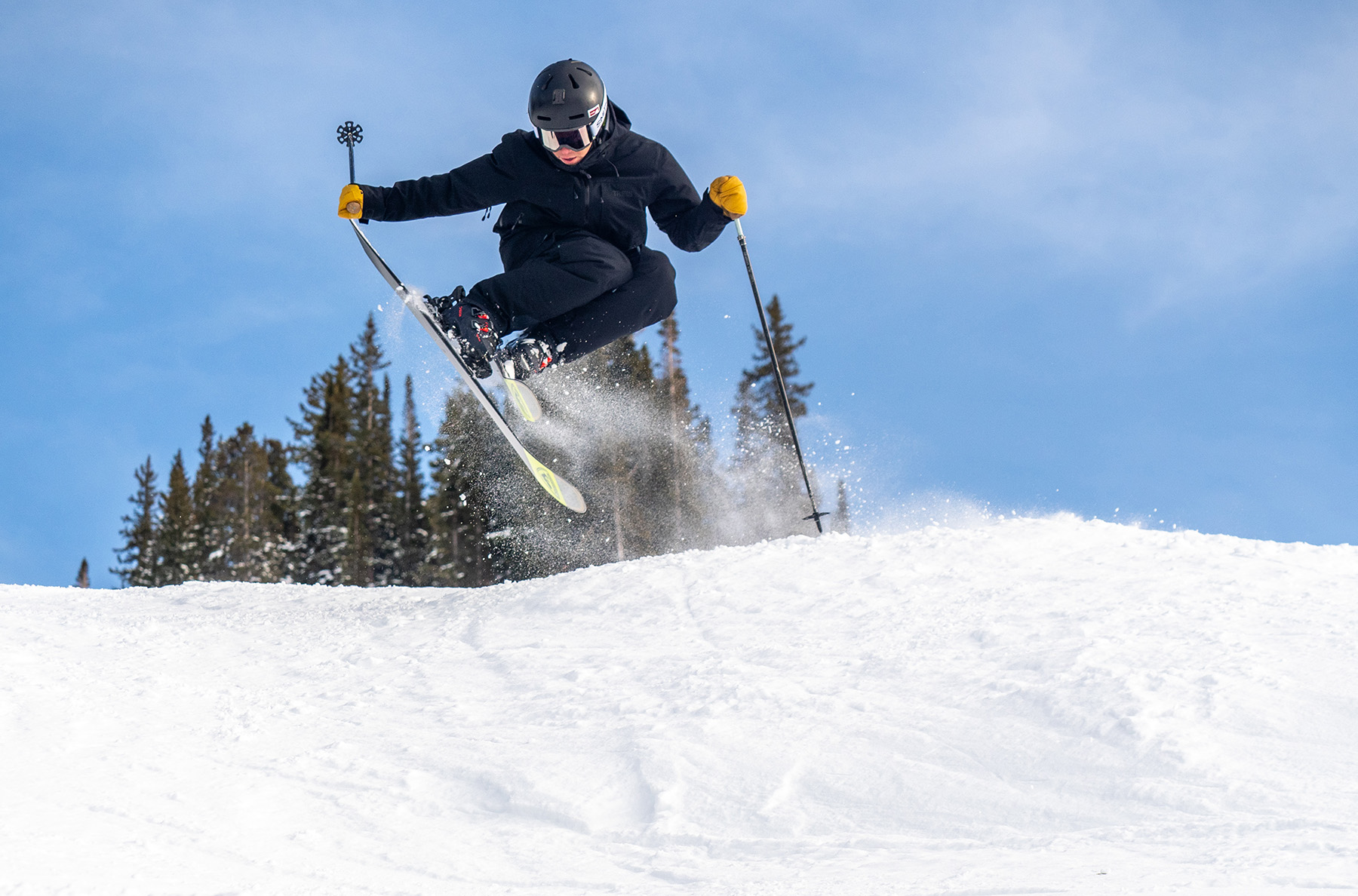


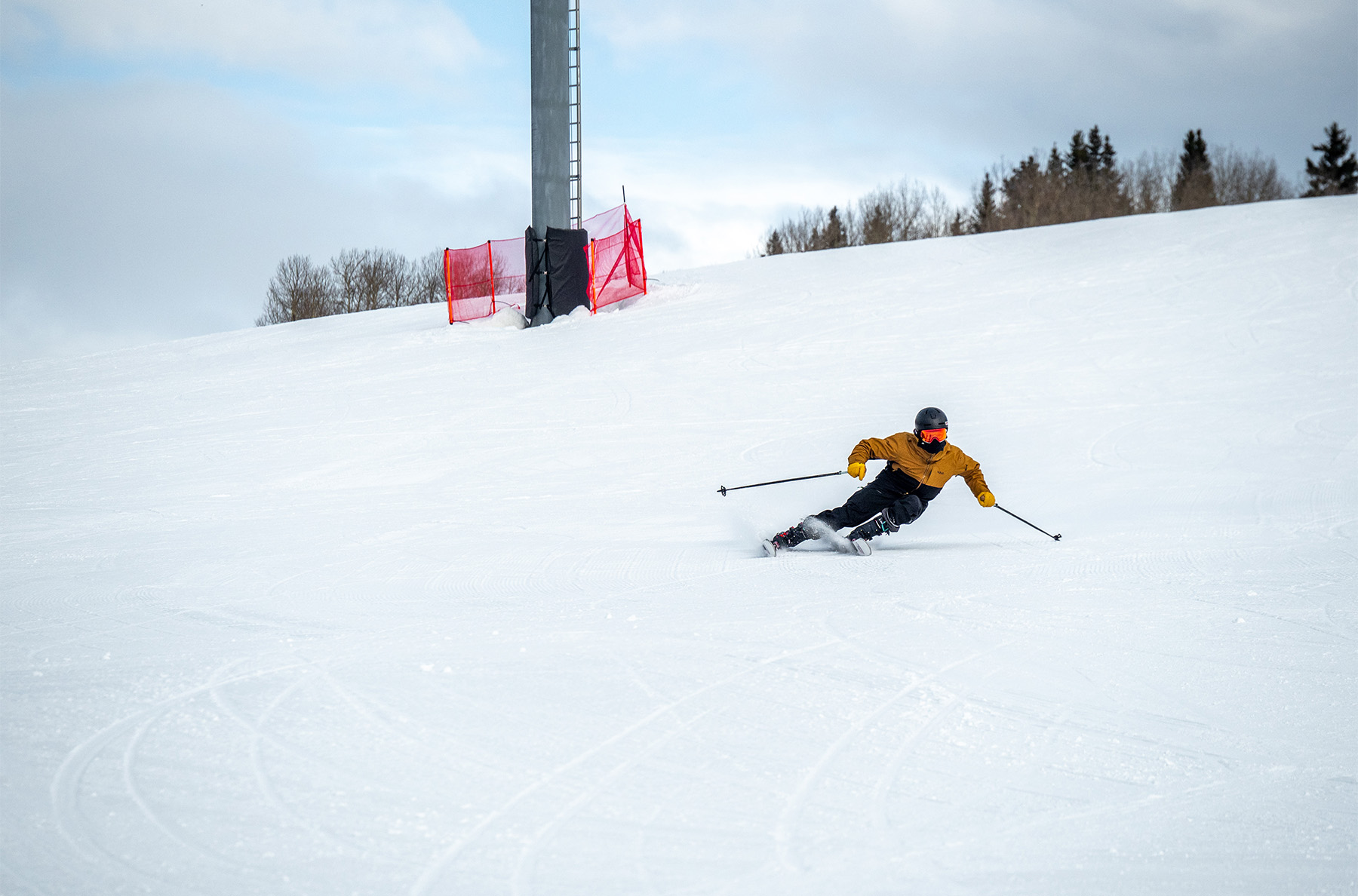
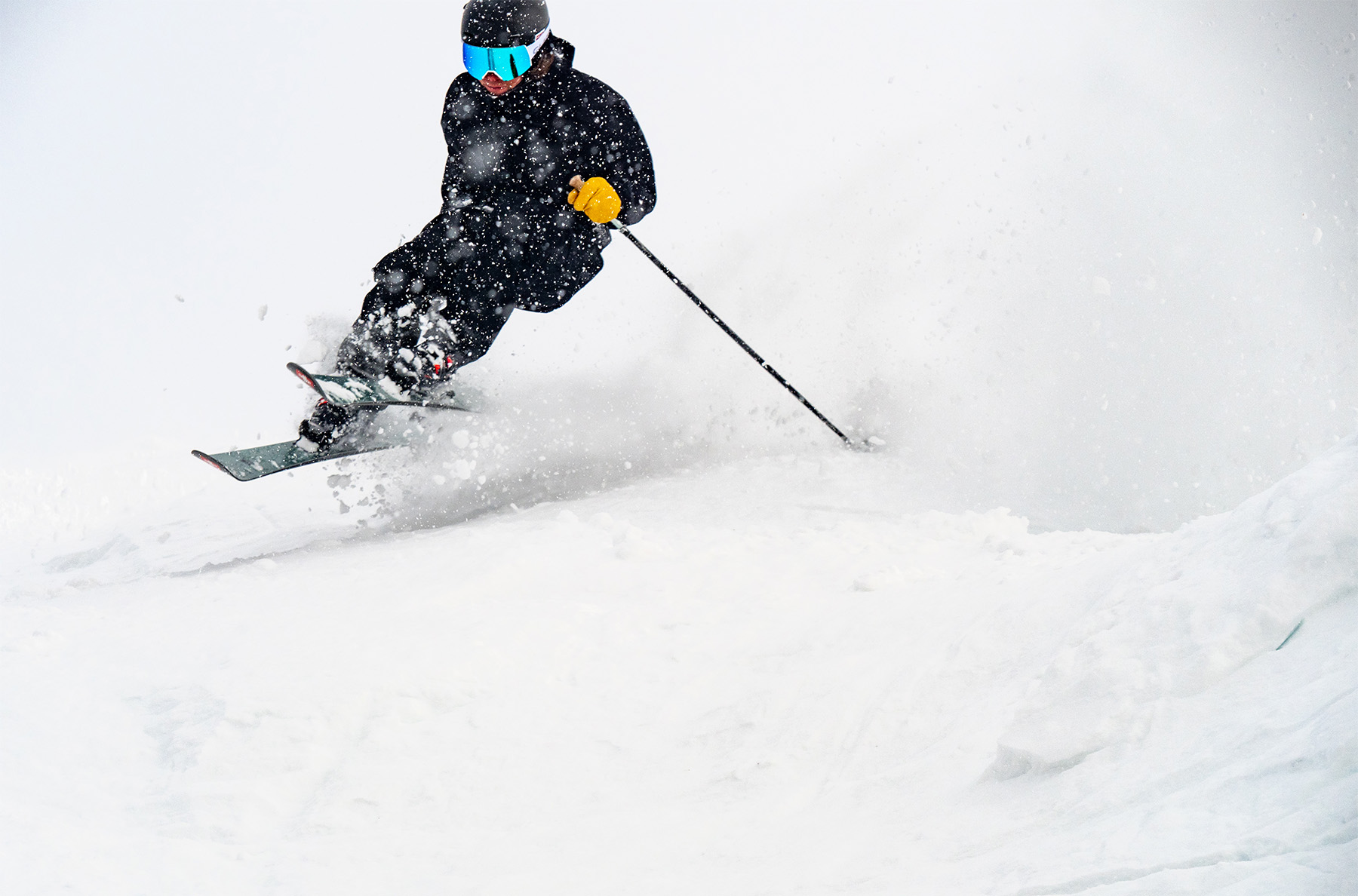
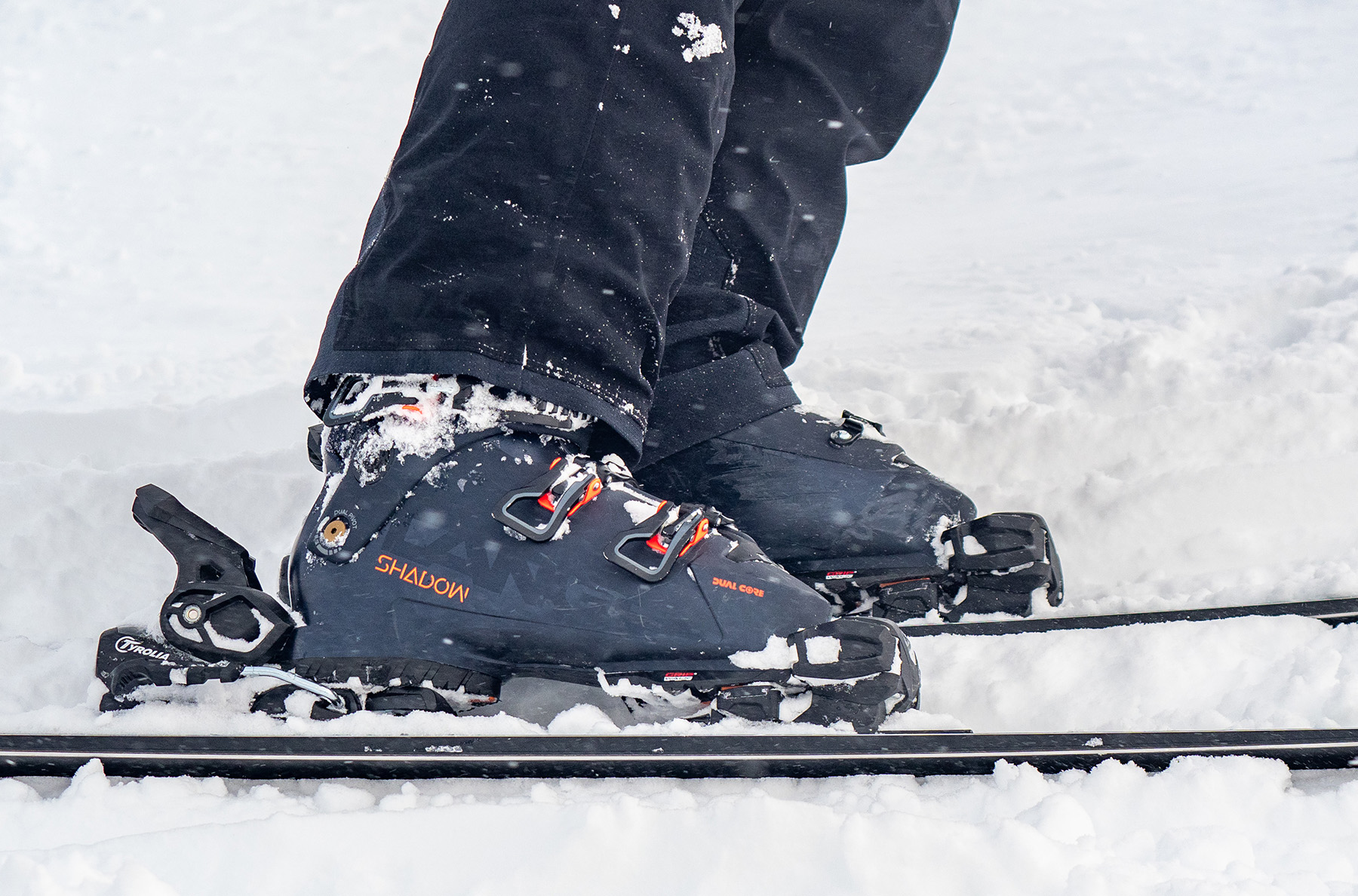
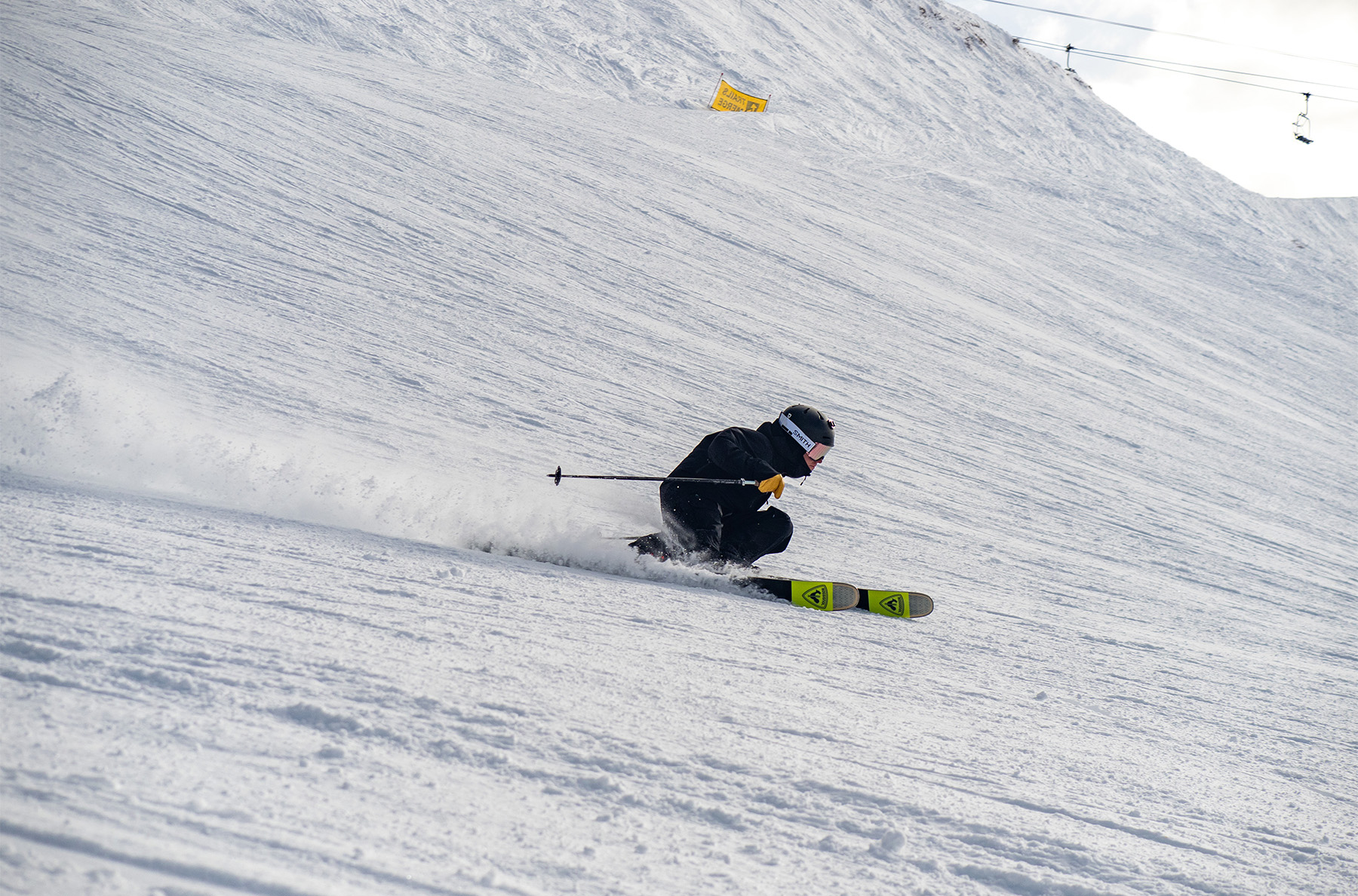
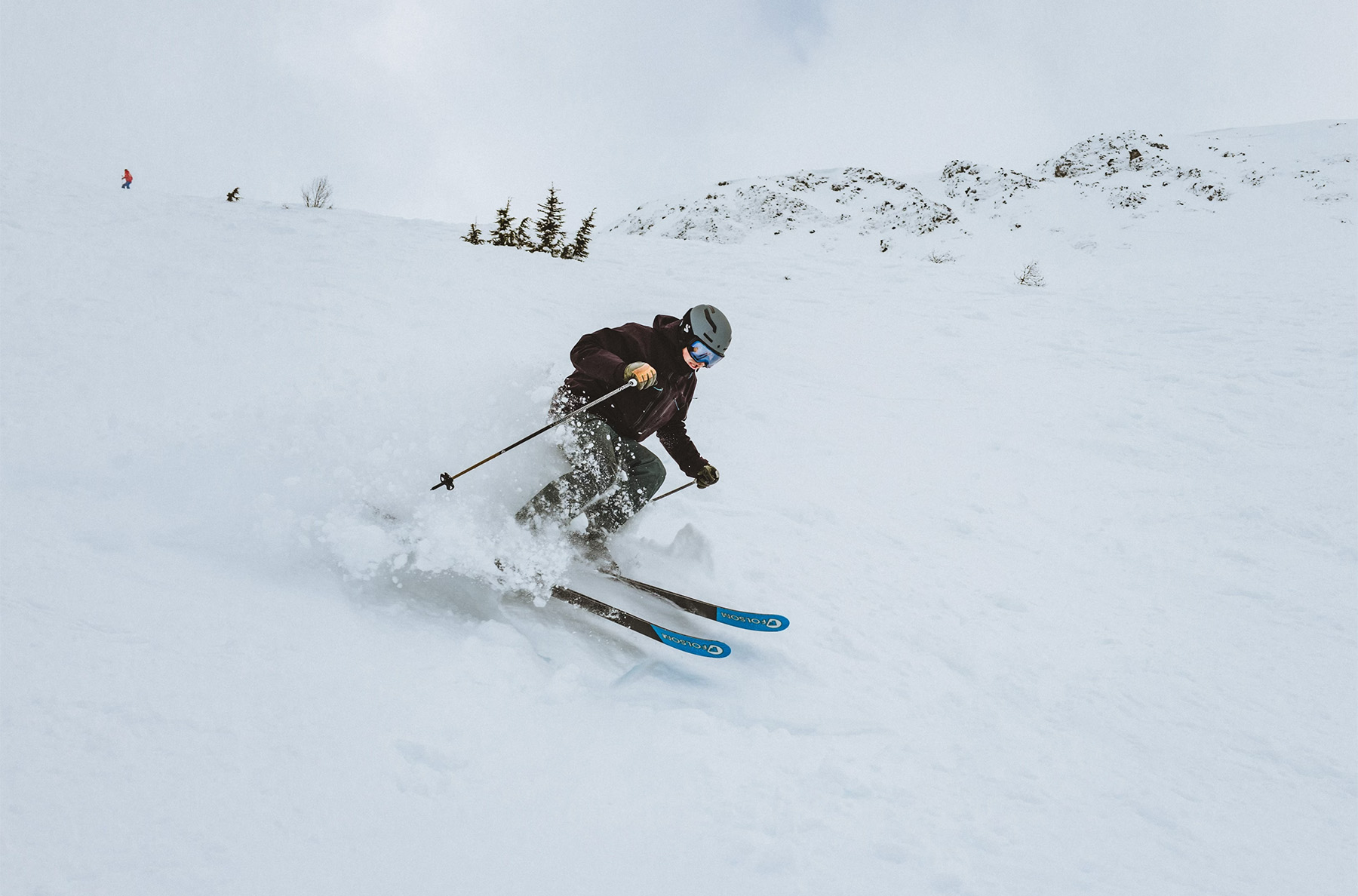
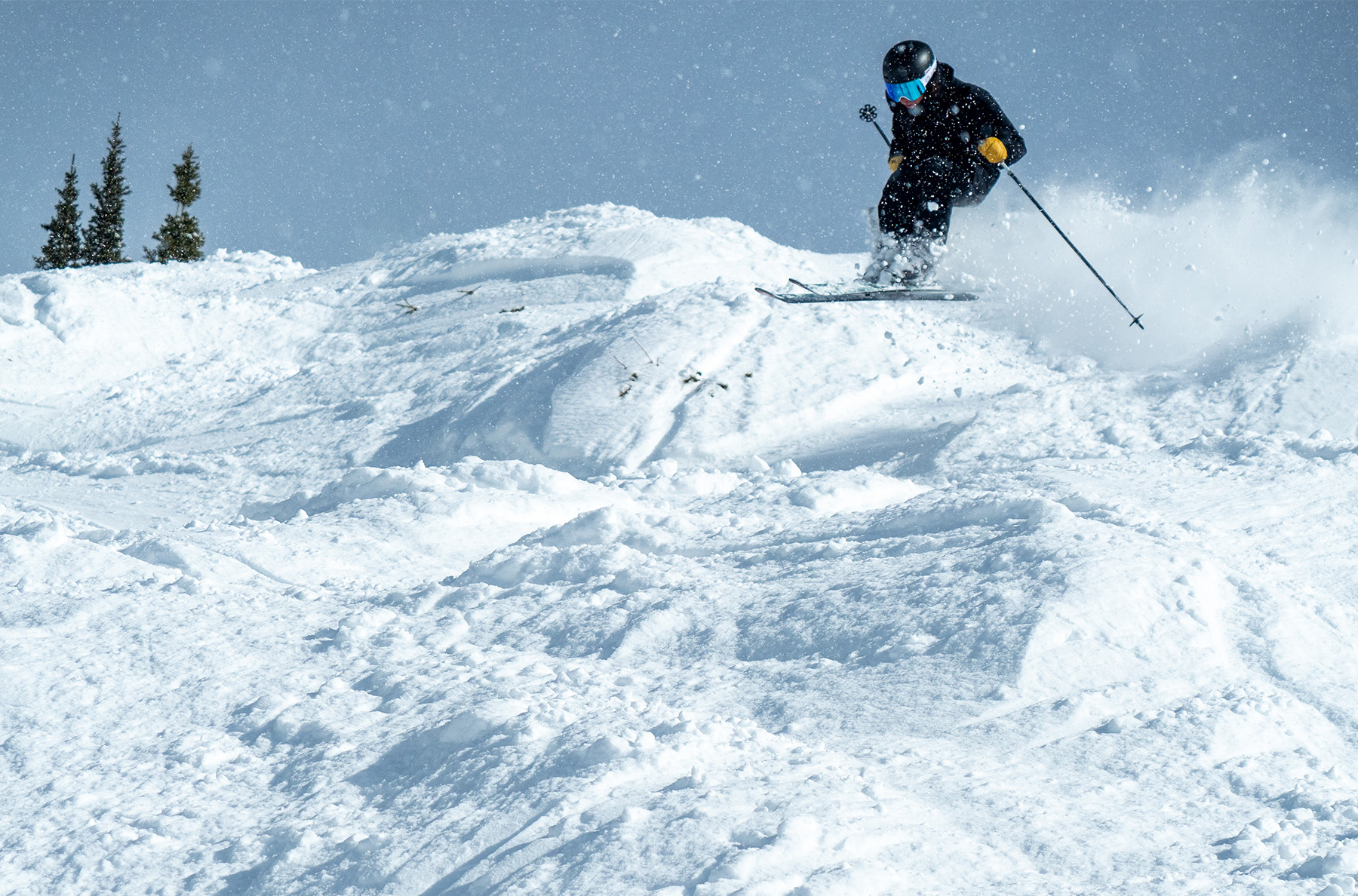
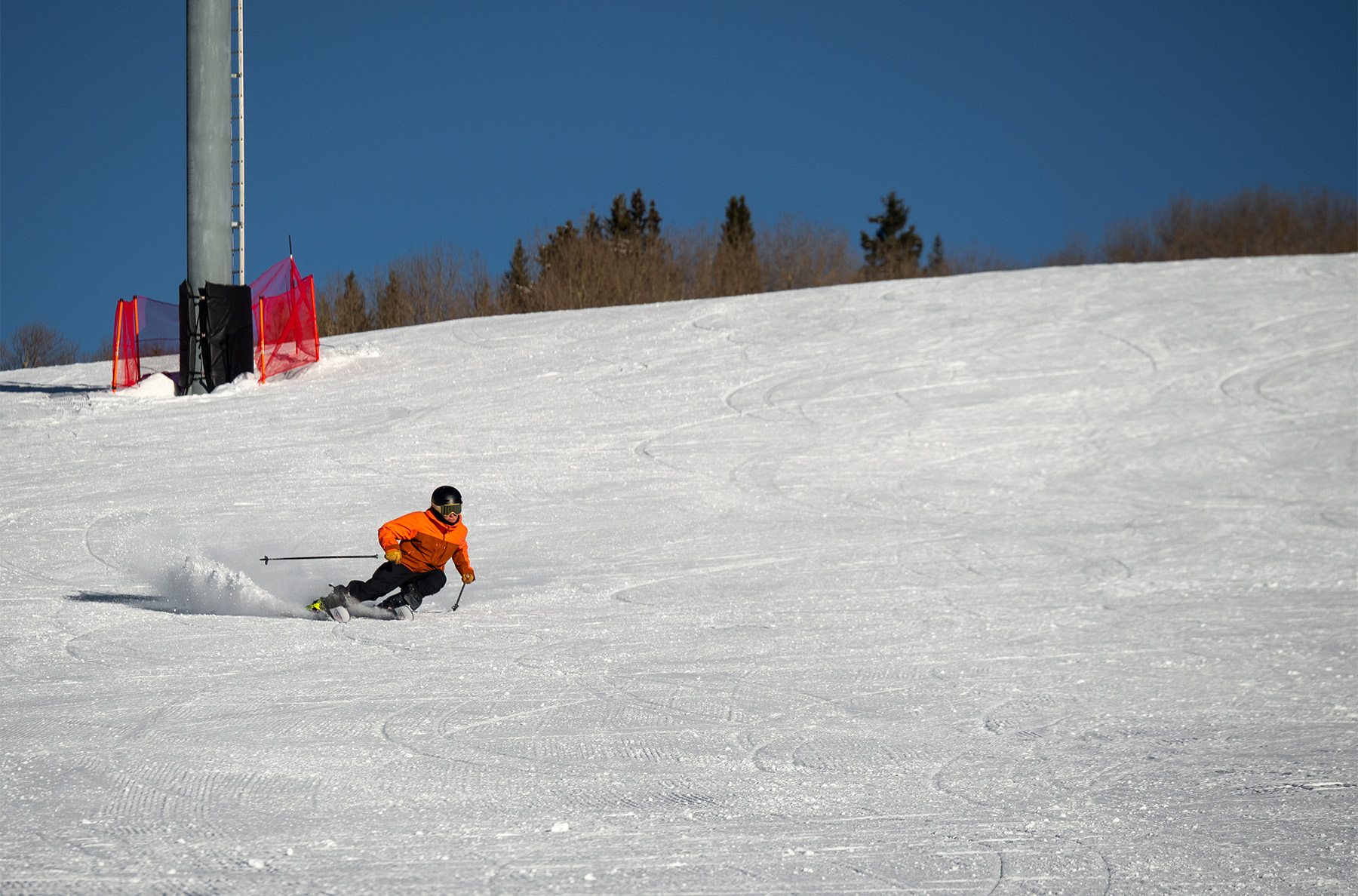
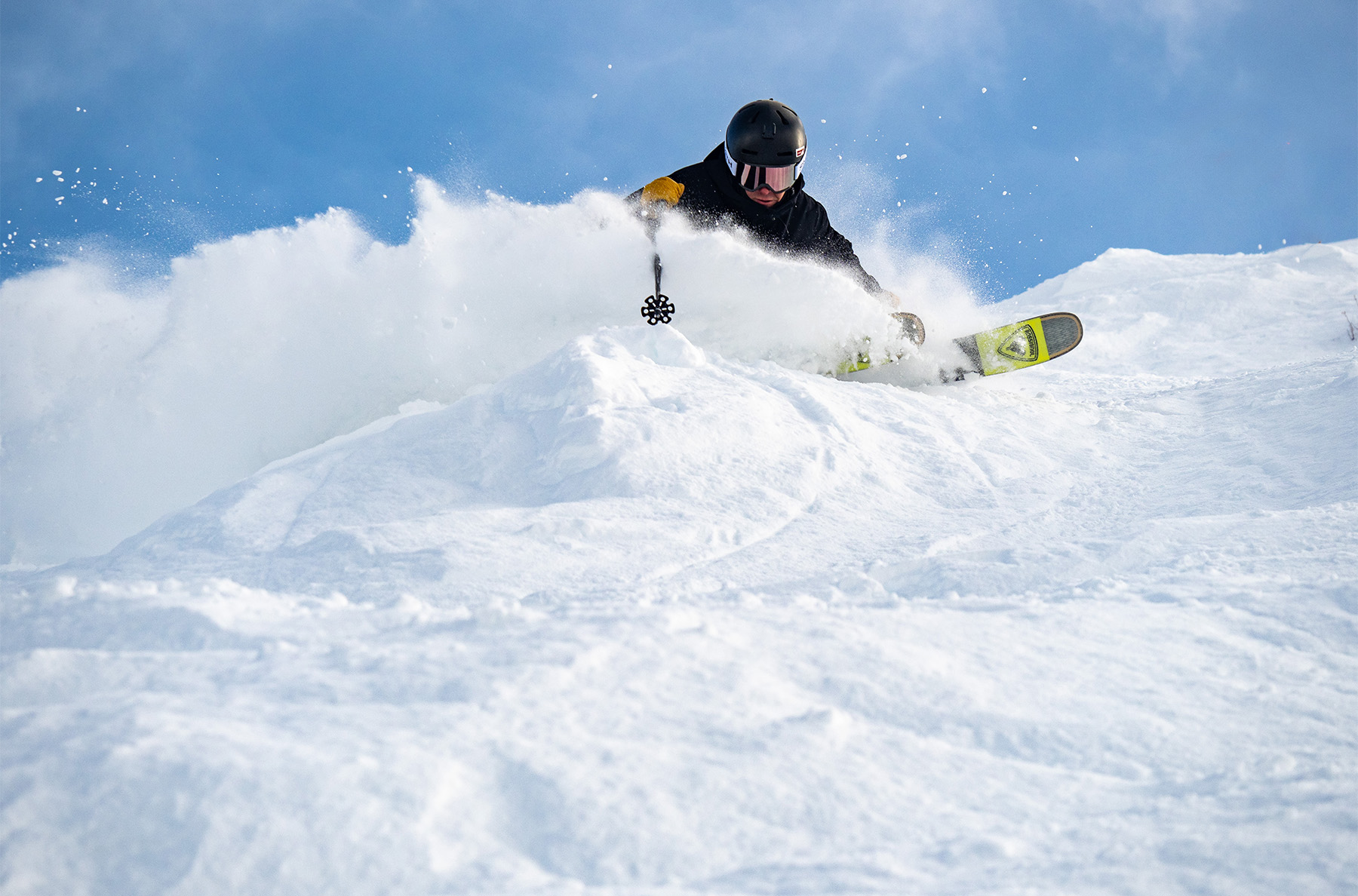
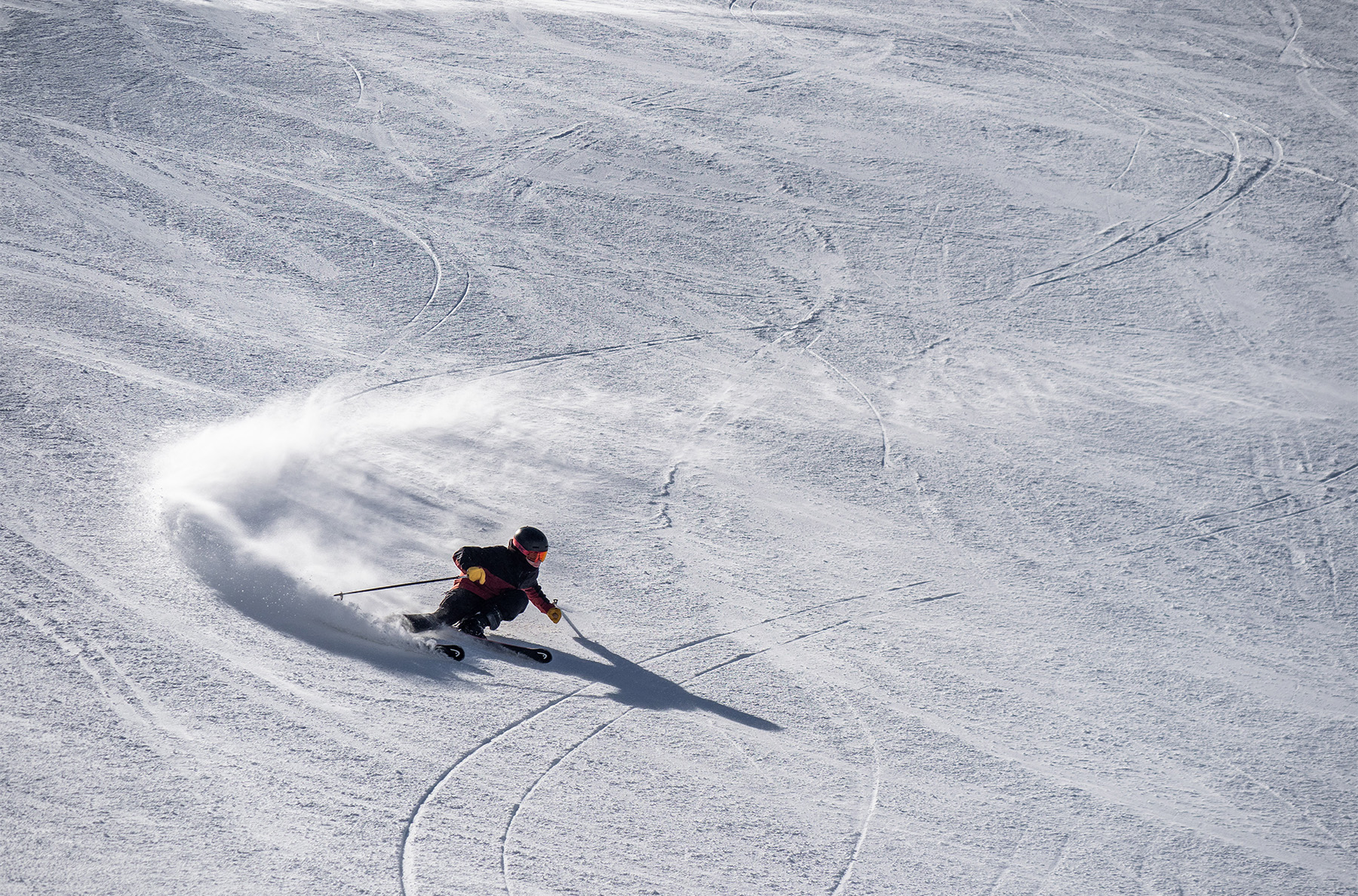
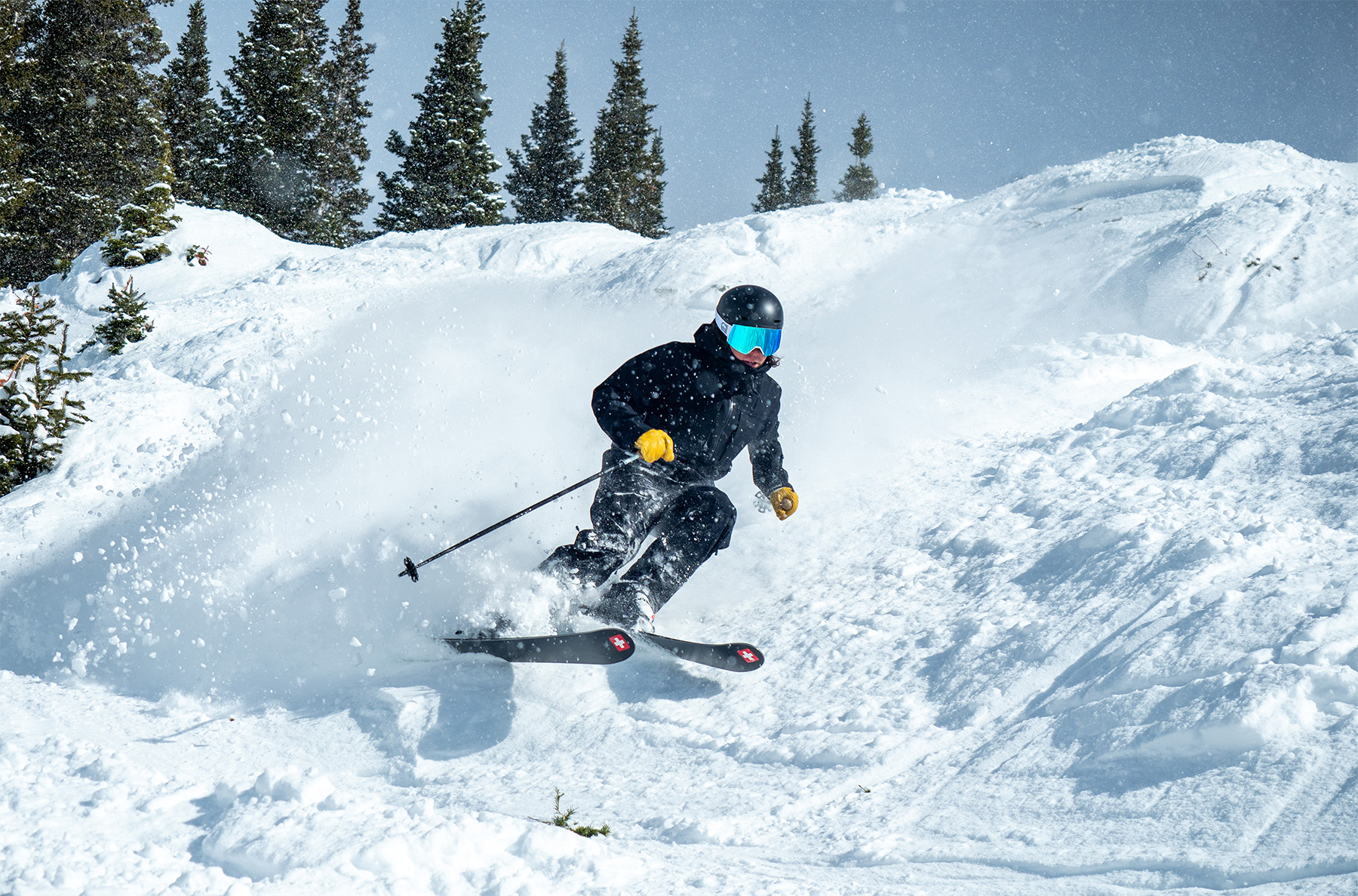
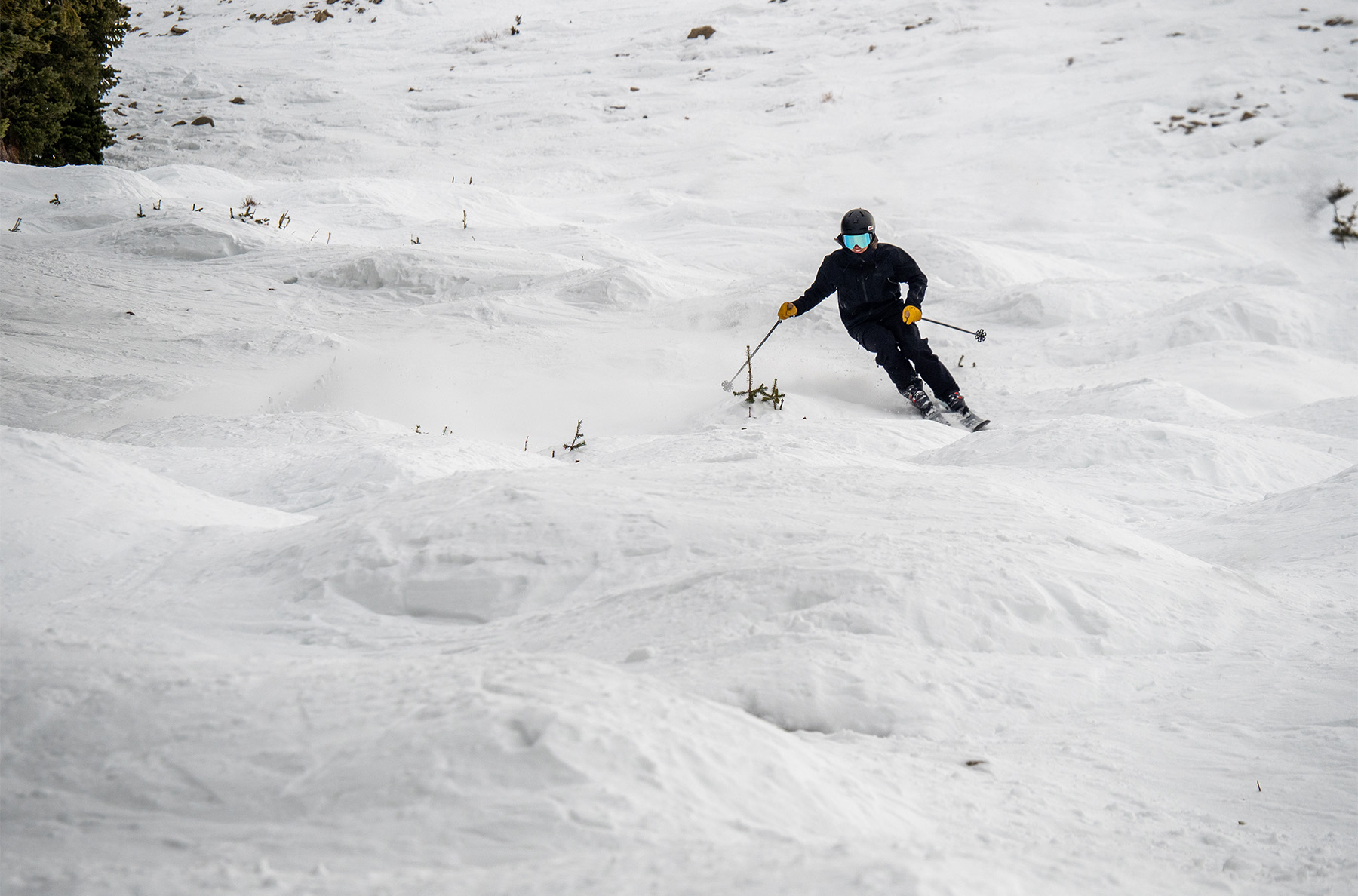
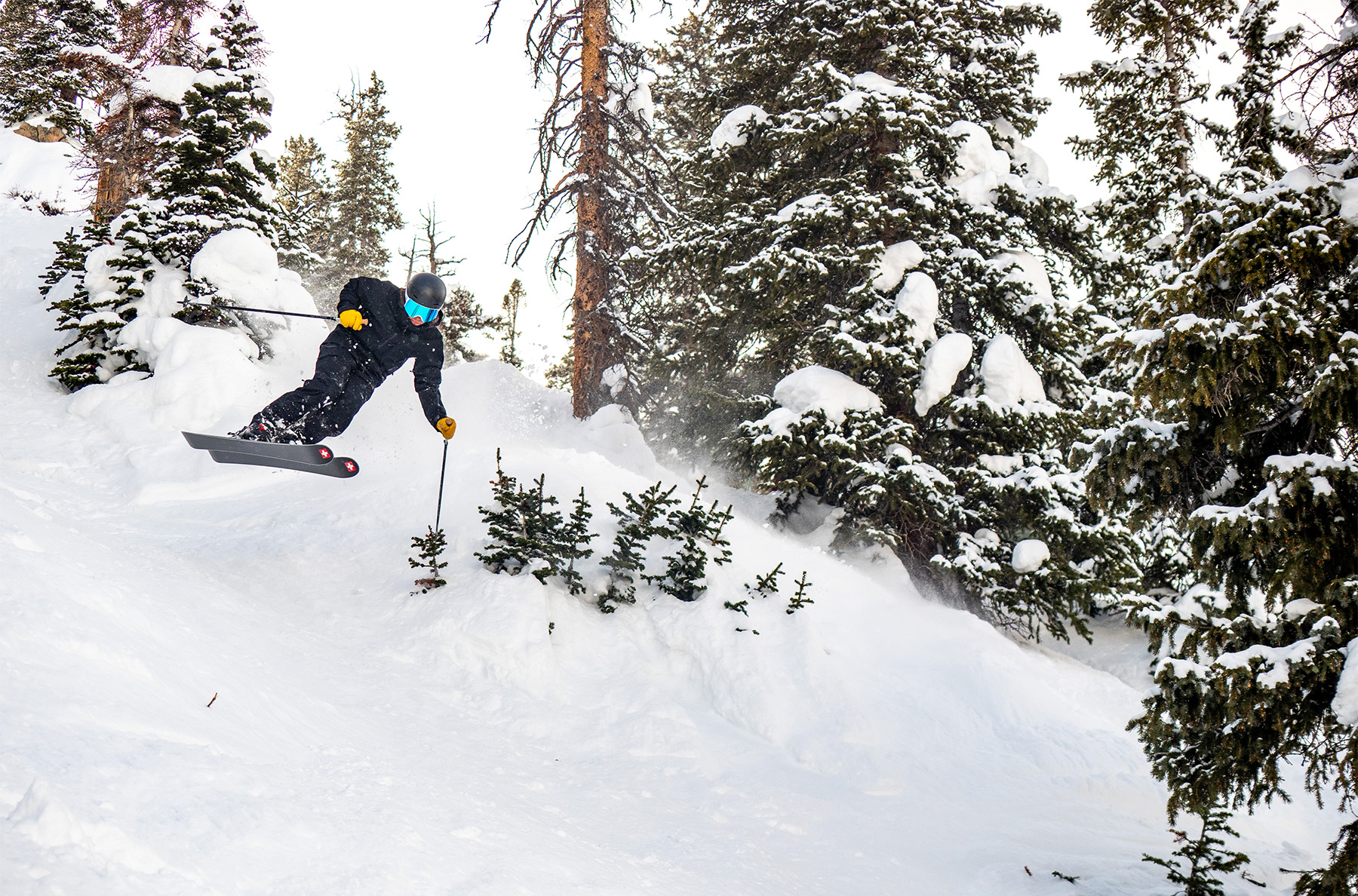

Hmm Luke, there seems to be a mistyped combo of words here!
“ increasing energy absorption and rebound” it can’t be both right? After all, rebound means returning movement by NOT absorbing energy.
So is that foam supposed to increase rebound or damping(energy absorption)? I can see a benefit to either, so not saying it’s bad either way, just trying to figure out which it is.
Thanks!
He’s just quoting the press materials… ask Lange!
A great “suspension” system could however rebound desirable inputs while absorbing undesirable ones, so both are possible!
I have been skiing this for the past month and I am stoked!
Can you describe your experience?
What is the forward lean angle?
12 and 16 with the spoiler.
How much are the ski boots
Tjaard – actually Im pretty sure that rebound is indeed a result of absorption, the flexed boot holds energy and returns it in the form of rebound. The energy not absorbed is passed through to the bindings then the ski and ultimately the snow (and a tiny bit is dissipated as heat).
The 130 RX LV is wider than the Tecnica Mach1 130 LV. If the fit is similar I will never buy them.
It doesn’t seem to be generating much commentary out there.., shame I thought we were on to something!
“…traditional 2-piece boots, which have a more progressive / elliptical power delivery, wherein they don’t transfer all that much power at first (and are easier to bend at first), but then ramp up significantly the deeper / harder you flex them.” I don’t understand – why wouldn’t I want this? The sublime progressive nature of my RX120s & RX130s are a big part of why I love them. Best recreational alpine boots on the market, IMO (if they fit).
Also, I see Lange STILL has not put rear pull-straps on their alpine boot. Aargh! C’mon Lange – virtually every other brand has these and with good reason. It makes getting into the boots much easier and they tend to not shoot off across the parking lot as I’m trying to get my feet in. And I haven’t found anyone who can sew some on.
I tried on the Shadow 130 this week. I was disappointed in the change in the heel cup. For me, the heel had slightly more volume and less of the traditional Lange heel lock. I’ve been in Lange boots for 20+ years because the heel cup locks me down. I tried on the RS 130 for comparison and BOOM, that heel cup is what I expected from a Lange. I believe the RX is a warmer boot than the RS and cold feet is an issue for me so I’m going to get a last year or earlier version of the RX 130. It’s frustrating when a tried and true product that has had a history of success for locking a heel down gets changed.
Rebound and absorption can happen together in suspension—not a typo.
They have based this boot on bike suspension, and the concept is brilliant, especially for a bouncier skiing style.
People already using it—developed enough to take a go, or wait for next iteration?
I’m super happy with my Shadow. I agree with the takes in this review.
a note on fit… I’ve always struggled with both heel hold and forefoot pain, as I have a relatively small/mid heel as compared to my massively wide forefoot.
FWIW, my 3 most recent previous shells have been LV Langes (with TONS of forefoot punching). With these Shadows I tried both the LV and MV and found the heel pocket/hold to be almost exactly the same, which allowed me to go up to the MV for much more comfort and still equal or better hold and performance compared to my previous boots.
* Same boot fitter and same ZipFit liners in all those 4 shells.
If you generally fit Langes, get Shadows.
Iv been skiing the 100 flex for most of this season and I think they undersold how different they feel initially.. these replaced my old Lange RX100 and my first few days and I would describe my experience as squirrelly.
I was def over flexing and then get thrown back into position on a dime and it was a bit jarring.. but in those first few days a few times I found the sweet spot and it felt amazing…
Now after several days I have figured the boots out and like Luke said I don’t think about it.
Amazing boot! I don’t mountain bike so I was totally lost with those analogies so I will use my own. It’s like going from a gas car to an electric car. You get instant torque, there no ramp up to get the power. You just gotta tap the accelerator and u go and barely let off and u start to slow(rebound).
Ha, I like the car analogy!
Luke/Paul, have you tried the different elastomers, grey vs. black. I am closer to Paul’s height and weight. My last two boots have been the RS 130 Wide, favorite boot of all time for me.
Paul has and we’re planning on updating this review with his thoughts. Long story short: he couldn’t tell a difference with the elastomers he swapped (I believe that the 130s ship with the stiffest available elastomers). If you liked the RS 130 MV, I suspect you’d get along very well with the Shadow 130 MV and its stock elastomers (though, as we noted, there might be some sort of adjustment period, due to its different-feeling flex pattern).
First, what an astoundingly detailed review. These sound amazing, and possibly ideal for a guy that seems to be getting older every year. Ha. Three quick questions:
Can you comment in a bit more detail on the warmth of the stock liners? For context, I found my (favorite skiing of all time) Raptor 140s to possibly be colder than skiing barefoot. My current (not quite enough boot) Speedmachine 3 130s are shockingly warm.
How about ease of parking lot removal on cold days? Does the Shadow have the co-molded silicone flap over the instep to help with this? Again, Raptors hardest ever to remove in the cold, Speedmachines not so bad.
Finally, there is chatter on the interwebz about Lange having made a running change on the Shadow liner. Do you guys have any facts on that?
Thank you!
(1) We didn’t spend a ton of time in the stock liners in very cold temperatures, but my hunch is that they’re about average in terms of warmth, largely due to the fact that they’re not ultra-dense like, say, the Raptor’s liners. Fit also plays a huge role in warmth — based on the extra volume alone, I would bet that you’d find the Shadow warmer than the Raptor.
(2) Lange’s Dual Core construction doesn’t have visible cues where the softer vs. harder-durometer plastics are used, but I’ve found the Shadow very easy to get on and off. It feels a lot more malleable in that regard than the Raptor, and the Shadow’s increased instep room vs. that boot probably helps.
(3) Lange calls out the 24/25 Shadow’s liner as “new,” but they list all the same features for it as the 23/24 version, so I don’t know what (if anything) has changed. I’ll report back if I can get some clarity from Lange.
Where does this boot slot in the Lange lineup relative to the RS 130? Is it considered a higher or lower-performance boot?
Lange still positions the RS 130 as the “race-inspired” boot and it features a more traditional construction: heavier and stiffer polyether plastic, traditional single-pivot cuff, solid plastic sole, etc. The fit is likely very similar, since the RS 130 shared the same last as the 22/23 RX 130 (which is quite similar to the Shadow 130), but the RS 130’s stock liner is more substantial overall, which makes it feel a bit lower volume than an equivalent RX (and likely Shadow). If deciding between the two, their flex patterns should probably be the biggest considerations — the RS 130 is still a strong, well-damped boot but flexes in a more traditional fashion, with less of a quick ramp-up in stiffness at the beginning. The Shadow ramps up more quickly and, in our experience, more efficiently transfers skier input to the ski. However, as I hypothesized about above, I suspect some people who have been skiing race or race-inspired boots for years may still prefer something like the RS since its flex pattern is likely more in line with what they’re used to and they might not like the new, different flex pattern of the Shadow.
If one uses a custom liner, does the difference boil down to the flex pattern?
When you speak of ramping up more quickly, does that mean more force to the ski at a less aggressive amount of power input to the boot?
I ski an RS130 and like it but wish it were a bit stiffer. I use a custom liner and a booster strap. Had the Rx 130 in the past. Frankly, I could not tell much of a difference.
Will the Shadow or the RS be offered in a stiffer flex? I know it’s possible to get plug RS’s but have never gone down that route.
Yeah, the RS 130 and Shadow 130 do fit slightly differently (see Paul’s Fit notes), but the flex patterns are the main difference. And yes, it’s tough to succinctly describe (as evidenced by our lengthy notes on the flex pattern in the review), but both of us found that the Shadow, in short, transfers more force to the ski with less force required from the skier. FWIW, Paul makes a lot of comparisons to the “Lange Heritage 140” which was basically a limited-edition 140-flex RX, and he preferred the flex pattern of the Shadow 130.
I don’t know of any stiffer Shadows in the works, and they only offer the 97mm-last RS up to a 130 flex. Given that Paul has been skiing in various RX 130 and the Heritage 140 for many years and prefers the Shadow 130 in just about every regard, it seems like that’d be your best option.
I looked all over my first and recent Lange RS120 SC LV and there was no Last info on the boot. Any comments? It is probably 97 mm if the product isn’t ahead of the Lange online table. But, is this boot liner good enough for 100 days/2 years of skiing?
I believe the RS120 SC LV is a 97 mm last. As for the liner, that’s fairly subjective — I find that I want to add a shim to most stock liners after 50-75 days due to the play / room that develops as a liner packs out, but some people can go longer.
Sounds like it’s progressive and then linear? Did y’all ever find the bottom of the flex, or do you think a heavier (240lb) aggressive skier might top it out?
Paul pushes 240 lb with his guide gear and he has not had any issues bottom-out / reaching the end of the flex pattern. I’m much smaller, but also have had no such issues
Just acquired a pair of the Shadow 130LV. Added a brand new Booster strap in place of the velcro one provided. Ported my ZipFits over from my old pair of boots, the Lange RX 120. Now that I have one day in the Shadows, can’t wait for the 2nd. Great flex pattern, feel super strong over the ski edge, stronger than before in my RX line Lange’s. Super comfortable and have never felt stronger in what the boot does for me. This review by Luke and Paul is super thorough, and I appreciate it, thanks guys!
Sweet, glad to hear it!
I switched to the Shadow 130 LV a few days after this year’s Blister Summit, primarily because I also switched to the Zipfit Gara LV liner during the summit. Complicated story, but I decided I’d rather marry the Zipfits and divorce my old shells (Technica 120 LV), so I picked up the Shadow LV 130 on a pro deal. I now have about 25 days on them. I will say with exuberance that it is a remarkably responsive boot. I’ve moved away from 130s as I’ve gotten older, so I thought I’d immediately switch to the softer pieces to soften the flex, but there’s no need for that. The flex is so subtle and lovely and so responsive. The Shadow’s dual pivot thing is for real, and is not a gimmick. This is the primary reason why I’m sticking with them, for now. On the other hand: Total agreement re the stock power strap: just a cheap, basic velcro strap riveted to the shell, so you have to drill out the rivets if you want to use a Booster Strap (which I do). That shouldn’t be that way for a high end boot. Total agreement on the rubber damn thing where the forefoot overlap is: sliding Zipfits in is a total PITA. It catches on the laces as you enter and folds under, then you have to stick your finger in there to pull it out, etc. Why Zipfits, then, you might ask? #1: The stock liner was a non-starter for me, and here’s why (my opinion, of course): The LV is NOT “low volume,” at least for me and it sounds like for Luke as well. So a couple of days in the stock liner and, despite its very responsive flex and excellent heel cup, there was just too much volume in the stock liner. #2: Here’s my main beef with this boot, and it might be the reason why I move on at some point, and Luke talks about it: The LV is NOT “low volume”! (yes, I already said that), and I’ve had conversations with some other users who feel the same way. The shell fit / sizing is spot on length-wise and width / last-wise. My right foot is lower volume than my left over the instep, which I’ve always mitigated in various ways (thicker sock on the right foot, a small heel lift, whatever), which is why I switched to Zipfits. But I’ve put 2 tubes of cork into the lowest reaches of the tongue and a little on the lowest reaches of the left and right sides — on the right foot only — and I’m still using some boot-fitting rubber over the instep to take up volume. So, while I think this is a really responsive, genuinely impressive new design, I would caution those with a truly low volume foot (or a low instep) to be honest with yourself when you try on this boot. Finally, Luke, you said you took off the stock power strap and installed your Booster Straps: are you still using the strap on your Zipfit Garas then? Are you still using the laces as well?
Thanks for the feedback; I largely agree. Re: your question — I’ve so far kept the laces and velcro strap of my ZipFit Garas; I appreciate the added security they provide, though I always try to make sure the ZipFit’s velcro strap is lying flat inside the shells of my boots each time I put them on (rather than folded back on itself), otherwise I’ve found that it can create a pressure point. If it’s laying as it’s supposed to, I don’t notice it while skiing, and I think it adds just a bit of extra security / precision to the top of the liner / shell interface.
I spent a day in the 120 flex 97 last and found it to be impressive in terms of energy saving, power and responsiveness. The issues I ran into using demo boots with stock liners were a bit of pressure on the stop of my right foot and initially some pressure on my arches, which seemed to fade throughout the day. I expect that they are issues specific to my feet and would be addressed with a custom fit and ZipFit. I really liked the boots in terms of performance, was not cold at all and felt like I was way less tired than in my old Solomon boots with Surefoot liners. Unfortunately, Mammoth’s demo shops don’t carry the 130 flex. I’m 6’1″ and ~175 pounds. II’ll likely try the 130 when boots are back in stock next season and if that feels good, get them custom fitted with Zips.
I moved into Shadow 130 LVs last spring after reading this review, and retired my trusty old RS130 LVs. I’d reiterate what some others have said in comments, and what Luke and Paul captured in this excellent review.
1. The energy transfer is really impressive. For me (a non racer, former ski bum, now weekend warrior skiing 20-30 days/season), the positive benefits of improved input to the ski were immediate, noticeable from the first turn, and improve my skiing by giving me greater input with less effort. I did not experience an adjustment period, though as noted in the review others may.
2. The fit is sloppy compared with my RS130 LVs. I probably have 10 days in my Shadows, and while I enjoy the improved input to my skis, I get frustrated that my feet aren’t locked in, especially when skiing choppy snow or bumps. I skied the RS 130s with stock liners, and they served me well for many years, even after they were packed out. For this reason, I’ll likely become a new Zipfit owner in the near future–but that’s a surcharge people with lower volume feet might want to consider before buying these.
3. Assuming Zipfits solve my fit issues, I think the improved energy transfer that comes with the boot is well worth the tradeoff.
These points are basically the same as Kelly Murphy’s above, but wanted to add my 2 cents. Thanks to the Blister team for all of your detailed reviews.
I have zipfits in my shadows. You’ll notice a serious difference, especially if this is your first pair of custom liners. They do occupy more room than the stock liners, and will be a little heavier, but I bet you’ll be happy with the improved performance. Agree that as a Lange veteran, these are roomier in the forefoot than the others, and especially from the RS (I came from the RX and noticed a difference too).
Best reviews I think I’ve ever seen! So thorough. Many thanks for that. I’ve been skiing RX130s and I’m looking for a new pair. Was leaning towards either the RS130 or the Shadow130. You may have sold me on the Shadow, here. I have big arches and wide forefeet with bunions adding to the latter issue. My right forefoot, in particular, has given me lots of fitting issues over the years. I assume an MV will give me a bit more width? That may be part of the answer, with some customizations. My RX liner boot actually pinches down on my right forefoot, currently, and can cause my foot to go numb. Maybe custom liners could help salvage the RXs. But the Shadow sounds pretty awesome.
I bought the Shadows last spring. The bootfitter got me into the 130 LV’s and made a few spots bigger when it would help my feet. My first time in a low volume boot. My prior boot shells were the RX 120 and I have Zip Fit Gara LV’s helping me out. I must say that the review here is consistent with my experience. Immediately I noticed the edge grip and smooth flex with a nice responsiveness. I’ve never felt so close to the edges of my skis through the boot, and the flex/power combination is also refreshing compared to other experiences. The rest were “good” or “fine” in a long line of ski boots over the years. This is different level and a job to put on and ski in. My only question is that – how will they hold up? Will that materials break down faster than what I’m used to? the custom liners fit in no problem. For those who struggle with fit, please consider going with Zip Fits. Game Changer. These shells are amazing. So happy.
Looks like Lange is dropping a 140 flex shadow for the 2024/2025 season. Any plans to get on this, maybe send one to Paul?
Somehow missed this — we didn’t get in that boot this winter but will try to get one up to Paul next season.
I´m looking for a pair of LV shells (I plan on putting Zipfits anyway) and I have skied on RX130s LV for a long time and the fit has always been great.
Apologies if this is a stupid question, but are the shells of the Shadow LV and MV and the volume is modified by the liners or are they different shells? I have found a pair of MVs online that are at significantly cheaper than the LVs I have found so far, but since I cannot try them I wanted to check before jumping. Happy to spend more for a better fit of course
The shells are different volumes — for example, a size 26.5 Shadow LV has a stated last width of 97 mm, while the Shadow MV in the same size has a stated last width of 100 mm. So if you’ve had a good fit in the RX LV, I’d definitely recommend getting the Shadow LV.
I’m 6′ 3″, 185 lb, and skied over 100 days (instructor) in RX 100 LVs with Garas and Booster straps last season. While fun in easier terrain and for mellow cruising (a lot of my skiing, honestly), I did find those soft enough to be limiting when pushing harder, especially carving. How would I decide whether to go with 120 or 130 Shadows? I’ll again use my Garas and Boosters. The cost difference is negligible.